Index
This topic area covers statistics and information relating to life expectancy and healthy life expectancy including local strategic need and service provision. Further information relating to Causes of Death is given under Population, and further information relating to Stillbirth and Infant Mortality is given under Pregnancy, Infants and Early Years within Children and Young People. Further information on how life expectancy and healthy life expectancy are calculated is given within Life Expectancy within the Glossary.
This page contains information from the Office for Health Improvement & Disparities’ Fingertips. Information is taken ‘live’ from the site so uses the latest available data from Fingertips and displays it on this page. As a result, some comments on this page may relate to an earlier period of time until this page is next updated (see review dates at the end of this page).
Headlines
- Life expectancy at birth does not give the expected duration of life for a newborn; it gives a measure of expected life expectancy if the current age-specific mortality rates are applied throughout an entire lifetime, but of course, these are subject to changes over time. So, life expectancy gives an indication of the current health status of a population, rather than an expected duration of life. Life expectancy can be estimated at any age, and it is also common to estimate life expectancy at age 65 years. As contemporary morality rates will be more comparable to the actual mortality rates in the future over the next 15-20 years, life expectancy at age 65 years is more likely to represent a reasonable estimate of duration of life.
- Life expectancy at birth in Hull in 2021-23 was 75.3 years for men and 80.2 years for women. This compares with 79.1 years for men (a difference of 3.8 years) and 83.1 years for women (a difference of 2.9 years) for England.
- A relatively similar pattern over time occurred for men and women in Hull. Life expectancy at birth increased in Hull between 2001-03 and 2011-14, but then increases stalled, and decreased between 2011-14 and 2017-19 prior to the COVID-19 pandemic. In contrast, life expectancy at birth increased throughout the entire period 2001-03 and 2017-19 across England although the increases were smaller more recently compared to the start of the century.
- In Hull, life expectancy decreased between 2017-19 to a recent low in 2020-22 due to the COVID-19 pandemic. This was particularly the case for men, and whilst there were decreases nationally, they were not as large as the decreases in Hull. Life expectancy increases in Hull (and across the region and England too) between 2020-22 and 2021-23 as the year 2020 was removed from the three-year moving average.
- Life expectancy in Hull for 2021-23 is similar to what it was 12-13 years ago (2008-10 for men and 2009-11 for women).
- For 2021-23, male healthy life expectancy is 54.3 years so it is estimated that men in Hull spend 21.0 years of their life not in ‘good’ health which represents 27.9% of their lives (17.6 years for England representing 22.2%). For women, healthy life expectancy was 54.6 years so it is estimated that women in Hull spend 25.6 years of their life not in ‘good’ health representing 31.9% of their lives (21.2 years for England representing 25.5%).
- From local calculations, life expectancy at birth for 2021-23 ranged from 70.2 years to 80.1 years for men and between 75.9 years and 84.6 years for women across Hull’s 21 wards. Life expectancy was lowest in Central for both men and women, and highest in in Boothferry ward for men and in Kingswood ward for women. There was a clear and statistically significant trend in life expectancy at birth between men and women living in the most deprived areas of Hull compared to the least deprived areas of Hull. Life expectancy at birth was 9.0 years lower for men and 7.8 years lower for women living in the most deprived tenth of areas of Hull compared to those living in the least deprived tenth of areas of Hull.
- When examining changes in life expectancy over time, there were substantial differences among the wards in Hull, and there were a number of wards where life expectancy at birth had decreased between 2002-04 and 2021-23. For men, life expectancy at birth decreased in Beverley & Newland, Central, University, Drypool, Holderness, Southcoates, Newington & Gipsyville, and Pickering wards. For women, life expectancy at birth decreased in Beverley & Newland, Central, Orchard Park, West Carr, Marfleet, Derringham, and Newington & Gipsyville wards.
- Prior to the Office for National Statistics back-revising their population estimates, for 2020-21, there were 9.2 year and 7.4 year gaps in life expectancy between the most deprived and least deprived fifth of areas in Hull (69.9 versus 79.1 years for men and 76.1 versus 83.6 years for women). The largest contributions to this gap in life expectancy for men came from an excess deaths from circulatory disease (2.42 years), external causes (2.12 years), cancer (1.51 years), respiratory disease (1.01 years) and COVID-19 (0.80 years). For women, the causes that contributed the most to the gap in life expectancy between the most and least deprived fifth of areas of Hull were cancer (1.56 years), circulatory disease (1.41 years), respiratory disease (1.20 years), mental and behavioural disorders (0.82 years) and external causes (0.70 years).
- Life expectancy at age 65 years and healthy life expectancy (years in ‘good’ health) at birth and at age 65 years are also lower in Hull. People in Hull live more of their lives not in ‘good’ health. It is estimated that men in Hull who are aged 65 years will spend 8.9 years of their estimated remaining 16.7 years not in good health which represents 53% of their remaining life (compared to 8.6 years for England equating to 46% of their remaining life). For women aged 65 years, it is estimated they will spend 10.5 years of their estimated remaining 19.1 years not in good health which represents 55% of their remaining life (compared to 9.9 years for England equating to 47% of their remaining life).
- For 2019-23, people aged 65 years who are living in the most deprived tenth of areas of Hull are living around 5.2 years less for men and 4.8 years less for women compared to people living in the least deprived tenth of areas of Hull (13.8 versus 19.0 years for men and 16.2 versus 21.0 years for women). There are also significant differences across Hull’s wards for 2019-23 with life expectancy varying from 13.5 years for St Andrew’s & Docklands to 19.0 years in Boothferry among men and from 16.3 years for St Andrew’s & Docklands to 22.2 years in Holderness among women (excluding Central, Kingswood and University where population figures aged 65+ years are too small to make life expectancy calculations valid). It is possible to calculate life expectancy at age 50 years for these three wards for 2019-23. Central has the lowest life expectancy at age 50 years for both men (25.3 years) and women (29.0 years) of all wards (Hull average 28.6 years for men and 32.0 years for women), whereas both Kingswood and University are better than the Hull average which give an indication of life expectancy within these wards at older ages.
- The national inequalities gap between Hull and England has been increasing over time, and whilst the local inequalities gap between people living in the most and least deprived areas of Hull is variable it has not improved over time. The difference in the national and local inequalities gap is larger for men compared to women.
- People in Hull are dying earlier than they should and there are wide inequalities / differences in life expectancy both between Hull and England, and within Hull.
- From the A Matter of Life and Death report, “Social and economic conditions such as poverty, poor-quality housing, low-paid or unstable jobs all impact people’s physical and mental health. These ‘wider determinants of health’ are harming health and cutting lives short.”
The Population Affected – Why Is It Important?
Life expectancy at birth is used to assess health improvements over time, as well as differences in health between different groups, whether comparing different geographical areas, such as wards or local authorities; comparing between groups defined by deprivation status; or looking at different time periods within the same geographical area.
Life expectancy at birth does not give the expected duration of life for a newborn; it gives a measure of expected life expectancy if the current age-specific mortality rates are applied throughout an entire lifetime, but of course, these are subject to changes over time. So, life expectancy gives an indication of the current health status of a population, rather than an expected duration of life.
It is calculated from the mid-year population estimates produced by the Office for National Statistics, and the number of deaths that were registered in the respective year (not based on the year of the death occurrence). It is generally presented as a rolling average over three years to help reduce the impact on year-on-year variability.
Life expectancy can also be calculated for other ages, for instance, life expectancy at age 65 years is often reported. This will be more of a measure of the expectation of life as it is likely that the age-specific mortality rates over the next 15-20 years will be similar to the current age-specific mortality rates (assuming nothing dramatic happens to the current mortality rates such as a change due to a war, pandemic, miraculous medical intervention, etc).
However, life expectancy does not measure the quality of life. For this reason, Healthy Life Expectancy is calculated, using a statistical model to estimate the length of life expectancy likely to be lived in ‘good health’. This measure is the overarching indicator used within the Public Health Outcomes Framework published by the Office for Health Improvement and Disparities. From health surveys, men and women are asked about their health status to obtain the prevalence of ‘in good health’, and this is incorporated into the life expectancy calculations for each age group.
A related measure is disability adjusted life years (DALYs) which is a measure of overall disease burden, and broadly speaking is defined as the number of years of life lost due to ill health, disability or death. Medical conditions with high DALYs are conditions which impact on quality of life substantially for a long period of time.
Where there is a difference in the life expectancy between two geographical areas, it is also possible to examine the causes of death which contribute to the difference in the gap to assess where there is an excess of deaths for the geographical area with the lower life expectancy. Such analyses using been undertaken within The Office for Health Improvement & Disparities’ Segment Tool.
The Hull Picture
Summary
Further details are given below but the overall figures are summarised in the following table for 2021-23 for men and women.
Life expectancy at birth is 3.8 years lower (or 4.8% lower) among Hull men compared to England.
| Measure | Hull men | England men | Absolute difference | Relative difference |
| Life expectancy at birth | 75.3 | 79.1 | -3.8 | -4.8 |
| Healthy life expectancy at birth | 54.3 | 61.5 | -7.2 | -11.7 |
| Total years not in ‘good’ health | 21.0 | 17.6 | 3.4 | 19.3 |
| Percentage of life not in ‘good’ health | 27.9 | 22.3 | 5.6 | 25.3 |
| Life expectancy at age 65 | 16.7 | 18.7 | -2.0 | -10.7 |
| Healthy life expectancy at age 65 | 7.8 | 10.1 | -2.3 | -22.8 |
| Years not in ‘good’ health at age 65 | 8.9 | 8.6 | 0.3 | 3.5 |
| Percentage of life not in ‘good’ health at age 65 | 53.3 | 46.0 | 7.3 | 15.9 |
Life expectancy at birth is 2.9 years lower (or 3.5% lower) among Hull women compared to England.
| Measure | Hull women | England women | Absolute difference | Relative difference |
| Life expectancy at birth | 80.2 | 83.1 | -2.9 | -3.5 |
| Healthy life expectancy at birth | 54.6 | 61.9 | -7.3 | -11.8 |
| Total years not in ‘good’ health | 25.6 | 21.2 | 4.4 | 20.8 |
| Percentage of life not in ‘good’ health | 31.9 | 25.5 | 6.4 | 25.1 |
| Life expectancy at age 65 | 19.1 | 21.1 | -2.0 | -9.5 |
| Healthy life expectancy at age 65 | 8.6 | 11.2 | -2.6 | -23.2 |
| Years not in ‘good’ health at age 65 | 10.5 | 9.9 | 0.6 | 6.4 |
| Percentage of life not in ‘good’ health at age 65 | 55.0 | 46.9 | 8.1 | 17.2 |
Life Expectancy at Birth
In Hull, life expectancy at birth is estimated to be 75.3 years for men and 80.2 years for women for 2021-23 which is 3.8 years lower for men and 2.9 years lower for women in Hull compared to England.
Compared with benchmark
| Indicator | Period | England | Yorkshire and the Humber region (statistical) | Kingston upon Hull | East Riding of Yorkshire | North East Lincolnshire | North Lincolnshire | York | North Yorkshire UA | Barnsley | Doncaster | Rotherham | Sheffield | Bradford | Calderdale | Kirklees | Leeds | Wakefield |
|---|---|---|---|---|---|---|---|---|---|---|---|---|---|---|---|---|---|---|
Life expectancy at birth (Male All ages) | 2021 - 23 | 79.1 | 78.1 | 75.3 | 79.8 | 77.5 | 78.1 | 79.8 | 80.3 | 76.5 | 76.9 | 77.8 | 78.4 | 76.8 | 77.6 | 77.9 | 78.3 | 77.5 |
Life expectancy at birth (Female All ages) | 2021 - 23 | 83.1 | 82.1 | 80.2 | 83.4 | 80.9 | 82.8 | 83.6 | 84.0 | 80.5 | 81.0 | 80.9 | 81.9 | 81.4 | 82.3 | 81.6 | 82.5 | 81.3 |
| Indicator | Period | England | Yorkshire and the Humber region (statistical) | Kingston upon Hull | East Riding of Yorkshire | North East Lincolnshire | North Lincolnshire | York | North Yorkshire UA | Barnsley | Doncaster | Rotherham | Sheffield | Bradford | Calderdale | Kirklees | Leeds | Wakefield |
|---|---|---|---|---|---|---|---|---|---|---|---|---|---|---|---|---|---|---|
Life expectancy at birth (Male All ages) | 2021 - 23 | 79.1 | 78.1 | 75.3 | 79.8 | 77.5 | 78.1 | 79.8 | 80.3 | 76.5 | 76.9 | 77.8 | 78.4 | 76.8 | 77.6 | 77.9 | 78.3 | 77.5 |
Life expectancy at birth (Female All ages) | 2021 - 23 | 83.1 | 82.1 | 80.2 | 83.4 | 80.9 | 82.8 | 83.6 | 84.0 | 80.5 | 81.0 | 80.9 | 81.9 | 81.4 | 82.3 | 81.6 | 82.5 | 81.3 |
Among Hull men, whilst life expectancy had increased between 2001-03 and 2010-12 from 73.7 years to 76.6 years, it remained relatively static between 2010-12 and 2014-16 (ranging from 76.5 to 76.7 years). Since 2014-16, life expectancy has declined among Hull men to 76.2 years for 2017-19. However, there was a sharp fall to 75.0 years for 2020-22 which is mainly attributable to the COVID-19 pandemic (further information on the number of COVID-19 deaths can be found within Causes of Death in Hull under Population). The largest number of deaths where COVID-19 was the underlying cause of the death were registered between April and June 2020 and between November 2020 and February 2021 (further information is given within Coronavirus (COVID-19) within Health Factors under Adults). Among both men and women, there were 388 COVID-19 deaths registered during 2020, 323 deaths in 2021 and 116 deaths in 2022 among Hull residents. Whilst there was a decrease between 2017-19 and 2018-20, the impact on life expectancy was greatest for 2019-21 and 2020-22 as these included two and three years of COVID-19 deaths rather than one year of deaths as 2018-20 did.
Life expectancy has increased slightly in Hull in the last year between 2020-22 and 2021-23 by 0.3 years. The high mortality rate from the year 2020 is no longer included in the latest period 2021-23, and it is anticipated that life expectancy will increase further for 2022-24 when the year 2021 is no longer included within that three-year period.
Since the high of 76.7 years for 2012-14, male life expectancy has decrease by 0.7% to 2017-19, by 2.2% to 2020-22 and by 1.8% to 2021-23. Between 2017-19 and 2021-23, life expectancy reduced by 0.9 years for Hull men. The reductions for England and the region (both 0.6 years) were lower.
Over the entire period between 2001-03 and 2021-23, male life expectancy at birth in Hull has increased by 1.6 years representing a 2.1% increase. Life expectancy increased by 2.6 years (3.4%) across the region and by 2.9 years (3.8%) for England. Thus the inequalities gap between Hull and England has increased.
Life expectancy at birth among Hull men in 2021-23 is the similar to what it was in 2008-10.
Compared with benchmark
Life expectancy at birth (Male All ages)
|
Period
|
Kingston upon Hull |
Yorkshire and the Humber region (statistical)
|
England
|
||||
|---|---|---|---|---|---|---|---|
|
Count
|
Value
|
95%
Lower CI |
95%
Upper CI |
||||
| 2001 - 03 | • | - | 73.7 | 73.3 | 74.2 | 75.5 | 76.2 |
| 2002 - 04 | • | - | 74.2 | 73.8 | 74.7 | 75.8 | 76.5 |
| 2003 - 05 | • | - | 74.3 | 73.9 | 74.7 | 76.1 | 76.8 |
| 2004 - 06 | • | - | 74.6 | 74.1 | 75.0 | 76.5 | 77.2 |
| 2005 - 07 | • | - | 74.6 | 74.2 | 75.1 | 76.8 | 77.5 |
| 2006 - 08 | • | - | 74.8 | 74.3 | 75.2 | 77.0 | 77.8 |
| 2007 - 09 | • | - | 74.9 | 74.5 | 75.4 | 77.3 | 78.1 |
| 2008 - 10 | • | - | 75.4 | 75.0 | 75.9 | 77.6 | 78.4 |
| 2009 - 11 | • | - | 75.9 | 75.4 | 76.3 | 78.0 | 78.8 |
| 2010 - 12 | • | - | 76.6 | 76.1 | 77.0 | 78.2 | 79.1 |
| 2011 - 13 | • | - | 76.6 | 76.1 | 77.0 | 78.4 | 79.3 |
| 2012 - 14 | • | - | 76.7 | 76.3 | 77.1 | 78.6 | 79.4 |
| 2013 - 15 | • | - | 76.6 | 76.2 | 77.1 | 78.6 | 79.4 |
| 2014 - 16 | • | - | 76.5 | 76.0 | 76.9 | 78.7 | 79.5 |
| 2015 - 17 | • | - | 76.2 | 75.7 | 76.6 | 78.6 | 79.5 |
| 2016 - 18 | • | - | 76.3 | 75.8 | 76.7 | 78.7 | 79.6 |
| 2017 - 19 | • | - | 76.2 | 75.8 | 76.6 | 78.7 | 79.7 |
| 2018 - 20 | • | - | 75.9 | 75.5 | 76.4 | 78.3 | 79.3 |
| 2019 - 21 | • | - | 75.2 | 74.8 | 75.6 | 78.1 | 79.0 |
| 2020 - 22 | • | - | 75.0 | 74.6 | 75.5 | 77.9 | 78.9 |
| 2021 - 23 | • | - | 75.3 | 74.9 | 75.7 | 78.1 | 79.1 |
Source: Office for National Statistics
Life expectancy at birth among Hull women show a reasonably similar pattern compared to men although the increase overall were smaller, and the impact of the COVID-19 pandemic was smaller.
Female life expectancy decreased between 2001-03 to 2002-04 from 79.4 years to 79.1 years, and then remained relatively unchanged until 2005-07 when it increased to 79.4 years in 2006-08. Female life expectancy at birth did then increase in Hull to a high of 80.7 years in 2011-13. The rate then fell to 80.1 years in 2015-17, and whilst there was an increase to 80.4 years in 2016-18, life expectancy remained unchanged until 2017-19 at 80.4 years. Life expectancy decreased from 80.4 years prior to the pandemic to 79.9 years for 2020-22, and similar to men, life expectancy has increased in the last year to 80.2 years for 2021-23. As the mortality rate from COVID-19 was higher among men, female life expectancy was less affected by the pandemic than male life expectancy (further information on the number of COVID-19 deaths can be found within Causes of Death in Hull under Population).
Over the entire period between 2001-03 and 2021-23, female life expectancy at birth in Hull has increased by 0.8 years representing a 1.0% increase. Life expectancy increased by 1.8 years (2.2%) across the region and by 2.4 years (3.0%) for England. Thus the inequalities gap between Hull and England has increased.
Life expectancy at birth among Hull women in 2021-23 is the same as it was in 2009-11.
Compared with benchmark
Life expectancy at birth (Female All ages)
|
Period
|
Kingston upon Hull |
Yorkshire and the Humber region (statistical)
|
England
|
||||
|---|---|---|---|---|---|---|---|
|
Count
|
Value
|
95%
Lower CI |
95%
Upper CI |
||||
| 2001 - 03 | • | - | 79.4 | 79.0 | 79.8 | 80.3 | 80.7 |
| 2002 - 04 | • | - | 79.1 | 78.7 | 79.5 | 80.4 | 80.9 |
| 2003 - 05 | • | - | 79.0 | 78.5 | 79.4 | 80.6 | 81.1 |
| 2004 - 06 | • | - | 79.0 | 78.5 | 79.4 | 80.9 | 81.5 |
| 2005 - 07 | • | - | 79.0 | 78.6 | 79.5 | 81.0 | 81.7 |
| 2006 - 08 | • | - | 79.4 | 79.0 | 79.8 | 81.2 | 81.9 |
| 2007 - 09 | • | - | 79.9 | 79.4 | 80.3 | 81.3 | 82.1 |
| 2008 - 10 | • | - | 80.1 | 79.7 | 80.5 | 81.6 | 82.3 |
| 2009 - 11 | • | - | 80.2 | 79.8 | 80.7 | 81.9 | 82.7 |
| 2010 - 12 | • | - | 80.4 | 80.0 | 80.8 | 82.1 | 82.9 |
| 2011 - 13 | • | - | 80.7 | 80.3 | 81.1 | 82.2 | 83.0 |
| 2012 - 14 | • | - | 80.5 | 80.1 | 80.9 | 82.3 | 83.1 |
| 2013 - 15 | • | - | 80.3 | 79.9 | 80.7 | 82.3 | 83.1 |
| 2014 - 16 | • | - | 80.3 | 79.8 | 80.7 | 82.4 | 83.1 |
| 2015 - 17 | • | - | 80.1 | 79.7 | 80.5 | 82.3 | 83.1 |
| 2016 - 18 | • | - | 80.4 | 80.0 | 80.8 | 82.4 | 83.2 |
| 2017 - 19 | • | - | 80.4 | 80.0 | 80.8 | 82.4 | 83.3 |
| 2018 - 20 | • | - | 80.4 | 80.0 | 80.8 | 82.1 | 83.1 |
| 2019 - 21 | • | - | 80.1 | 79.7 | 80.5 | 82.0 | 82.9 |
| 2020 - 22 | • | - | 79.9 | 79.5 | 80.3 | 81.9 | 82.8 |
| 2021 - 23 | • | - | 80.2 | 79.8 | 80.6 | 82.1 | 83.1 |
Source: Office for National Statistics
Causes of Death with Excess Deaths in Hull Contributing to the Gap in Life Expectancy
The Office for Health Improvement & Disparities have produced a Life Expectancy Segment Tool, which examines the gap or difference in life expectancy and assesses the excess deaths that contributed to the difference in relation to different causes of death. The latest version uses mortality data for the two years 2020-21 and is based on the original population estimates. As a result, there will be changes to the gap and the contributions by cause once Segment Tool is updated.
Gap in Life Expectancy Between Hull and England
Circulatory disease and cancer were the causes of death which had the highest excess deaths in Hull contributing to the gap in life expectancy between Hull and England for 2020-21. If the age-specific mortality rates from circulatory disease were the same in Hull as they were for England, then life expectancy would be 1.10 years higher for men and 0.66 years higher for women in Hull, and if age-specific mortality rates for cancer in Hull were the same as for England, then life expectancy in Hull would increase by 0.87 years for men and 0.90 years for women.
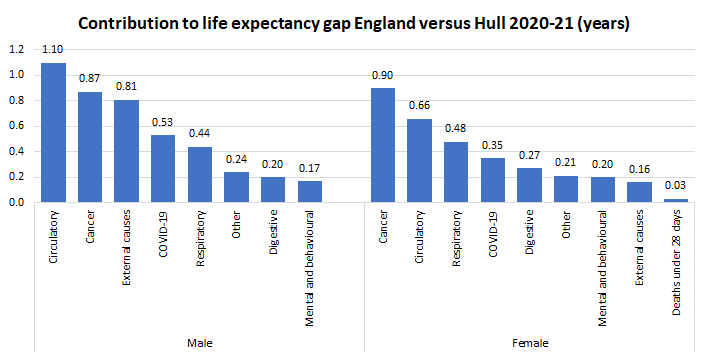
The gap in life expectancy between Hull and England for 2020-21 was 4.4 years for men (life expectancy 74.3 years in Hull compared to 78.7 years in England) and 3.3 years for women (life expectancy 79.4 years in Hull compared to 82.7 years in England). Thus circulatory disease accounts for 20% of the life expectancy gap for men and 25% of the gap for women, and cancer accounts for 20% of the gap for men and 28% of the gap for women.
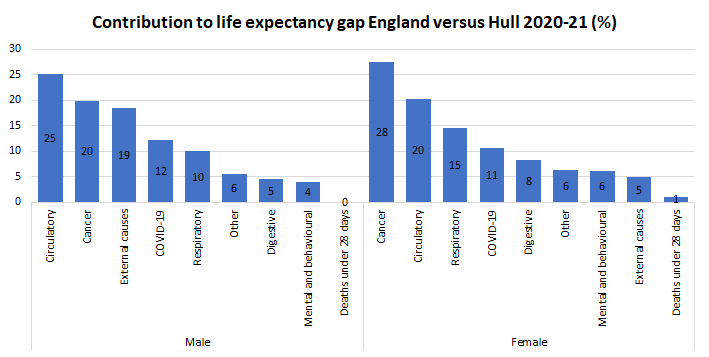
Gap in Life Expectancy Between Most and Least Deprived Areas of Hull
The Segment Tool also examines the gap in life expectancy between the most deprived fifth of areas and the least deprived fifth of areas within each local authority.
The Office for National Statistics ‘back-date’ their pre-Census estimates of the resident population once more accurate Census data becomes available. They have published their revised estimates for each local authority and for lower geographies, but have not yet updated the segment tool. There is a difference in the population estimates for Hull in the original estimates produced for 2020 and the revised back-dated estimates subsequently produced for 2020, so it is likely that the figures in the Segment Tool for Hull based on local deprivation fifths will change slightly.
In Hull for 2020-21, they estimate that life expectancy at birth is 69.9 years for men living in the most deprived fifth of areas of Hull compared to 79.1 years for men living in the least deprived fifth of areas of Hull giving a gap of 9.2 years. For women, their life expectancy at birth estimates are 76.1 and 83.6 years for the most and least deprived fifth of areas respectively giving a gap of 7.4 years.
Among men, circulatory disease contributes 2.42 years to this life expectancy gap, external causes 2.12 years and cancer 1.51 years. Among women, the causes with the greatest excess deaths contributing to the local life expectancy gap are for cancer (1.56 years), circulatory disease (1.41 years) and respiratory disease (1.20 years).
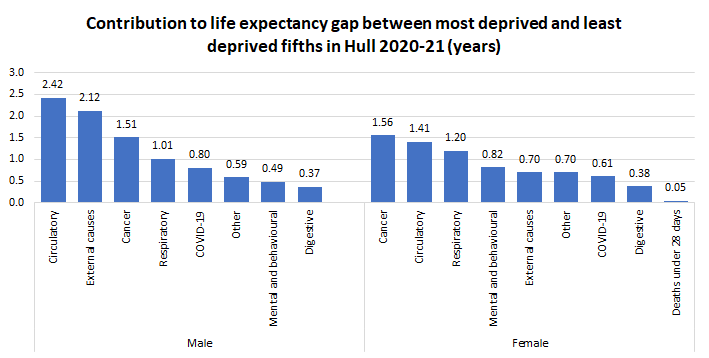
In total, excess deaths due to circulatory disease and external causes contribute to almost half of the gap in life expectancy between the most and least deprived areas of Hull among men (26% and 23% respectively). Among women, cancer (21%), circulatory disease (19%) and respiratory disease (16%) contribute to just over half of this local gap in life expectancy.
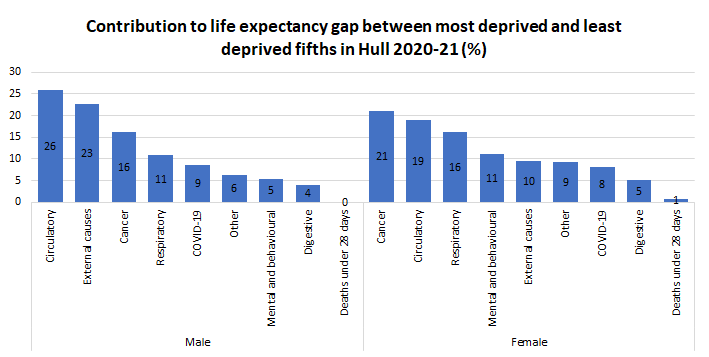
Life Expectancy at Birth Among Local Deprivation Groups
Life expectancy at birth differs among the local deprivation tenths defined on the basis of the Index of Multiple Deprivation 2019. The 95% confidence intervals are shown (for more information see Confidence Intervals in the Glossary). If the confidence intervals do not overlap then there is a statistically significant difference in life expectancy, although the reverse cannot necessarily be said if there is overlap (it is possible for statistically significant differences to exist when there is a small overlap between groups).
It can be seen that there is a clear trend in life expectancy at birth among Hull men based on where they live with life expectancy 9.0 years lower among men living in the least deprived tenth of areas of Hull compared to men living in the least deprived tenth of areas of Hull for 2021-23.
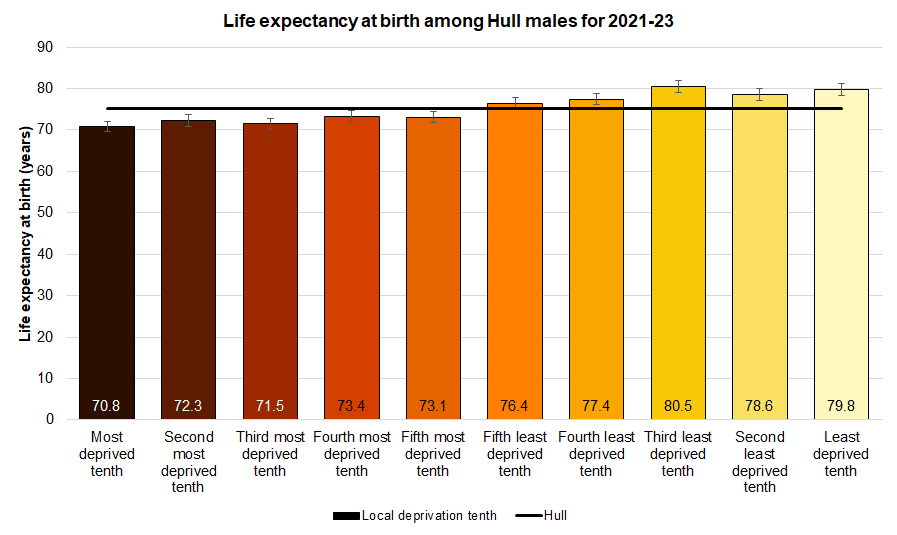
When comparing local deprivation fifths, the gap is slightly smaller with male life expectancy at birth 7.6 years lower among men living in the least deprived fifth of areas of Hull compared to men living in the least deprived fifth of areas of Hull for 2021-23.
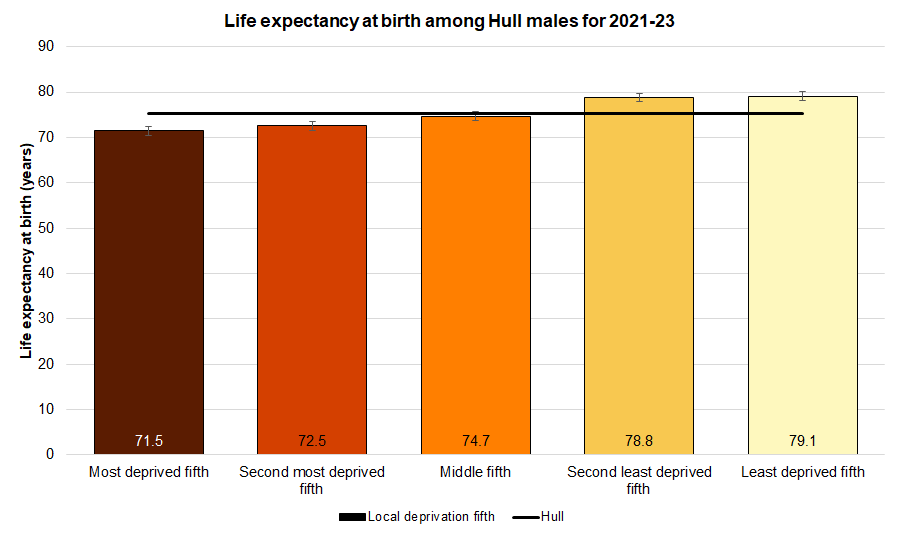
Between 2002-04 and 2021-23, male life expectancy increased by 1.5 years (or by 2.2%) for men living in the most deprived fifth of areas of Hull, by 0.2 years (or by 0.3%) for men living in the second most deprived fifth of areas of Hull, by 2.1 years (or by 2.8%) for men living in the second least deprived fifth of areas of Hull, and by 1.0 years (or by 1.3%) for men living in the least most deprived fifth of areas of Hull. However, among men living in the middle fifth of areas of Hull, life expectancy at birth decreased by 0.2 years (or by 0.2%) between 2002-04 and 2021-23.
Comparing the most deprived fifth with the least deprived fifth, the local inequalities gap in male life expectancy at birth has decreased. The difference was between 8.5 and 9.2 years for the four year period 2002-04 to 2005-07, but between 7.2 and 8.1 years for the four year period 2018-20 to 2021-23.
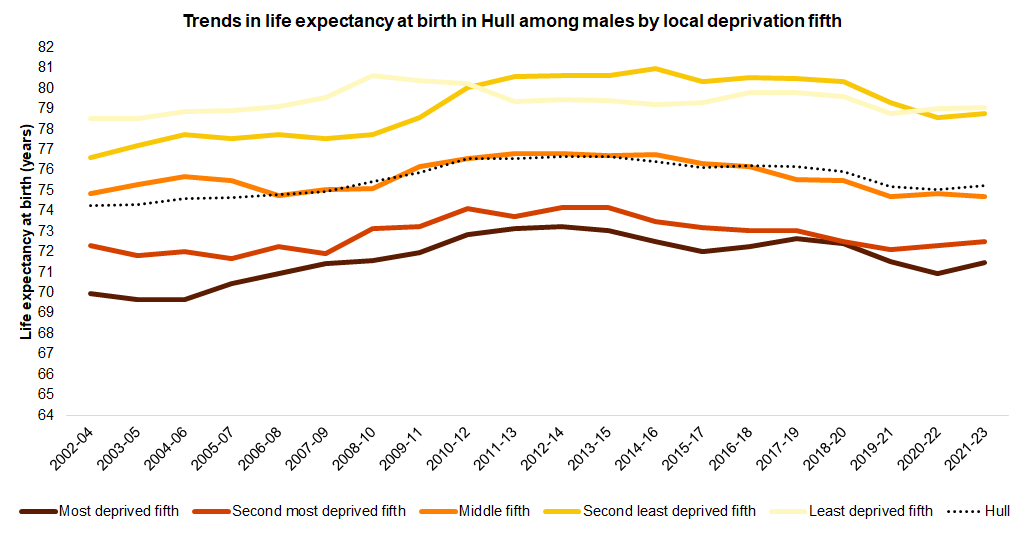
There is also a statistically significant difference in life expectancy at birth among Hull women based on where they live. Female life expectancy is 7.8 years lower among women living in the least deprived tenth of areas of Hull compared to women living in the least deprived tenth of areas of Hull for 2021-23.
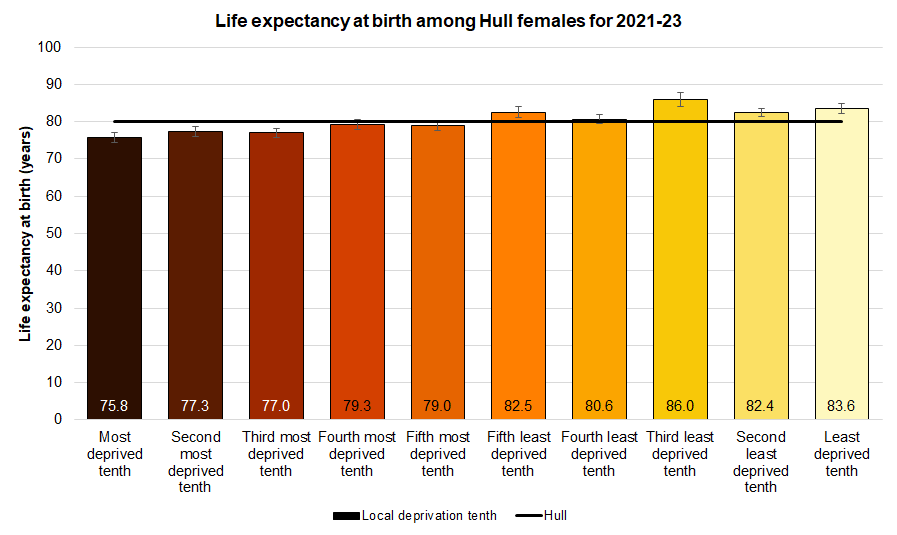
When comparing local deprivation fifths, the gap is slightly smaller with female life expectancy at birth 6.4 years lower among women living in the least deprived fifth of areas of Hull compared to women living in the least deprived fifth of areas of Hull for 2021-23.
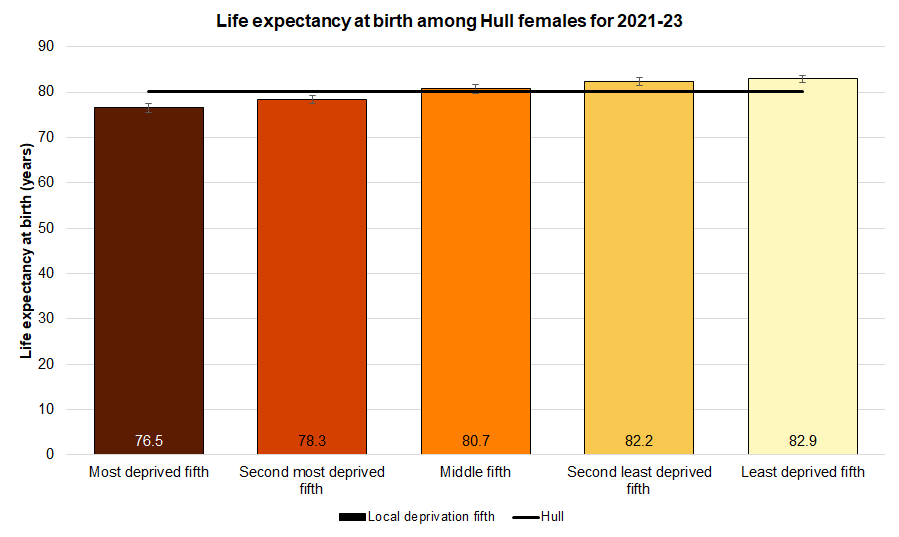
Between 2002-04 and 2021-23, female life expectancy increased by 0.8 years (or by 1.0%) for women living in the second most deprived fifth of areas of Hull, by 1.2 years (or by 1.5%) for women living in the middle fifth of areas of Hull, by 1.2 years (or by 1.4%) for women living in the second least deprived fifth of areas of Hull, and by 2.6 years (or by 3.2%) for women living in the least most deprived fifth of areas of Hull. However, among women living in the most deprived fifth of areas of Hull, life expectancy at birth decreased by 0.4 years (or by 0.6%) between 2002-04 and 2021-23.
Comparing the most deprived fifth with the least deprived fifth, the local inequalities gap in female life expectancy at birth has increased which is not surprising given that there has been a reduction in female life expectancy at birth among women living in the most deprived fifth of areas of Hull and the largest increase in female life expectancy at birth among women living in the least deprived fifth of areas of Hull. The difference in life expectancy between the most and least deprived local fifths was 3.4 years for 2002-04, although this did increase to a high or 7.4 years for 2005-07 before decreasing to a low of 4.4 years for 2011-13. The latest inequalities gap for 2021-23 is 6.4 years which is the third highest (after 6.7 years in 2006-08 and 7.4 years in 2005-07).
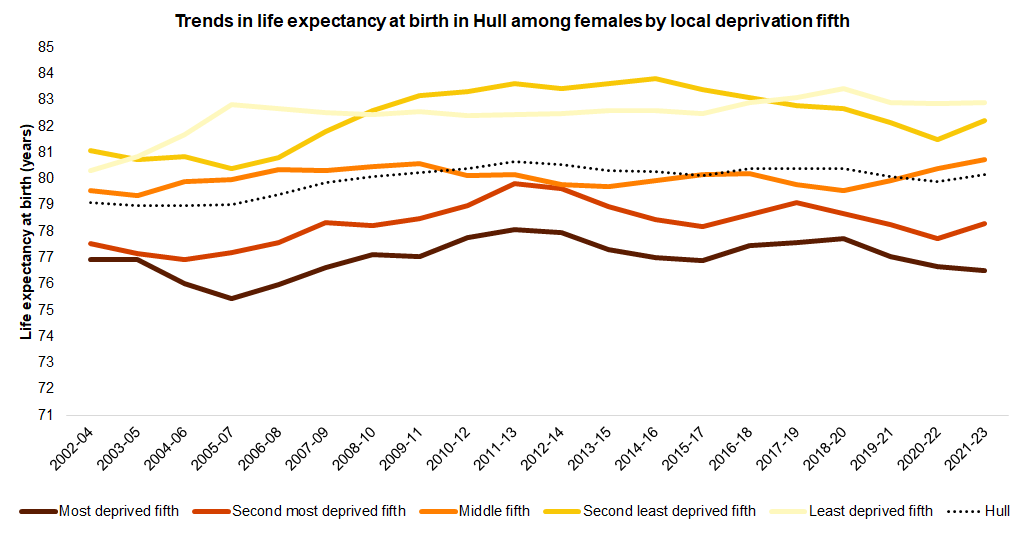
Life Expectancy at Birth Among Hull’s Wards
There are considerable differences in life expectancy across Hull’s 21 electoral wards with a gap between the wards with the highest and lowest average life expectancies at birth of 14.2 years for men and 11.4 years for women in Hull for deaths registered during 2021-23.
When linked to ward rankings based on the Index of Multiple Deprivation 2019 these inequalities tend to follow a trend of wards with the lowest deprivation ranking having some of the highest average life expectancies and wards with the highest deprivation ranking having some of the lowest life expectancies (although there were some exceptions to this trend).
Life expectancy at birth was 1.5 years lower for both men and women for every 10 unit increase in the ward deprivation score.
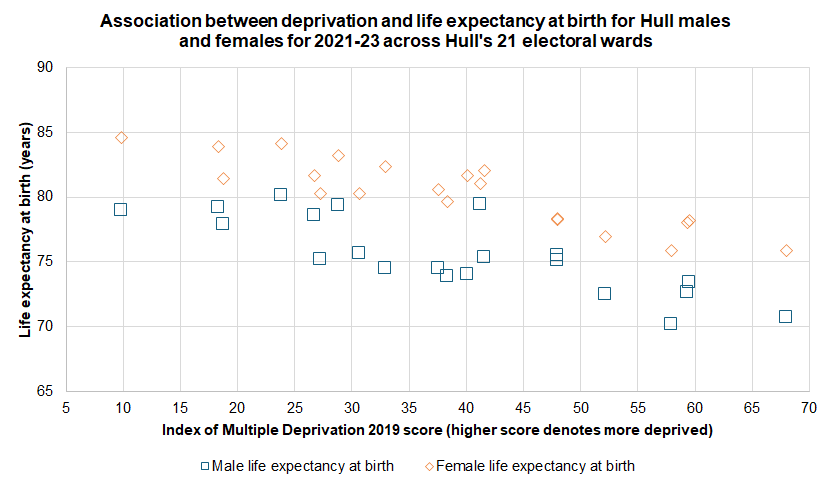
Male life expectancy at birth for 2021-23 varied from 70.2 years in Central ward to 80.1 years in Boothferry ward.
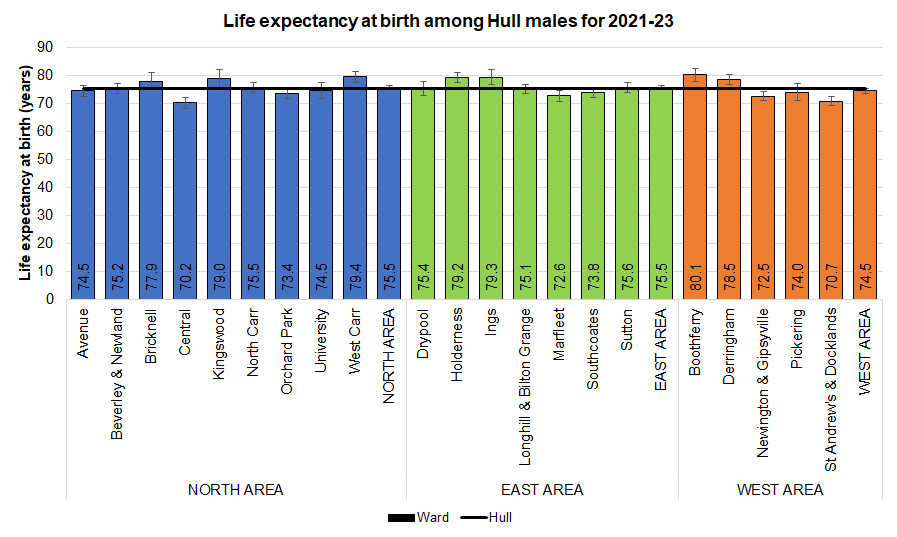
The charts below illustrate the trends in male life expectancy across Hull’s wards for North, East and West Area Committee Areas for selected years from 2002-04 to 2014-16 and then for the last five years (rolling average).
For the majority of wards in North Area Committee Area, there has been a decline in male life expectancy in the last four years at least in part due to the pandemic, and this has been particularly the case for Beverley & Newland, and Central wards.
Between 2002-04 and 2021-23, male life expectancy has decreased by 1.4 years in Beverley & Newland, by 1.3 years in Central, and by 0.8 years in University. Life expectancy has increased by 1.4 years in Avenue, by 0.2 years in Bricknell, by 2.9 years in North Carr, by 2.7 years in Orchard Park, and by 2.0 years in West Carr. The total population in Kingswood ward between 2002-04 and 2007-09 was too low for life expectancy calculations to be valid (fewer than 5,000 residents) so are not shown, and the figures are more variable for this ward due to the population size and its younger population with fewer deaths. Overall in North Area Committee Area, male life expectancy has increased by 1.4 years from 74.1 years in 2002-04 to 75.5 years in 2021-23 representing an increase of 1.8%.
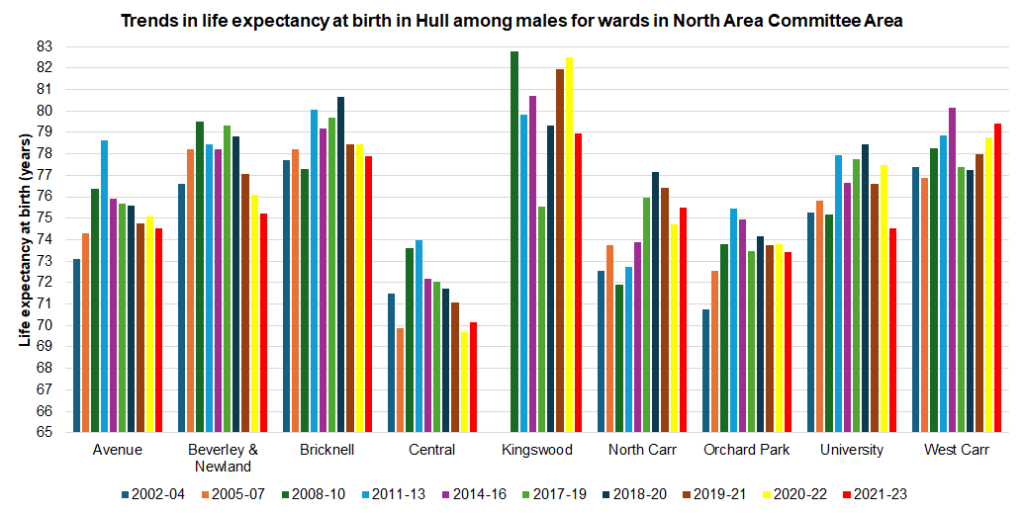
For the majority of wards in East Area Committee Area, male life expectancy has decreased in the last four years at least in part due to the pandemic, although there has been an increase for Ings and Longhill & Bilton Grange.
Over the period 2002-04 to 2021-23, male life expectancy has decreased by 0.9 years in Drypool, by 0.9 years in Holderness and by 1.2 years in Southcoates. Over the same period of time, male life expectancy increased by 4.1 years in Ings, by 2.2 years in Longhill & Bilton Grange, by 0.2 years in Marfleet and by 1.7 years in Sutton. Overall in East Area Committee Area, male life expectancy has increased by 0.6 years from 74.9 years in 2002-04 to 75.5 years in 2021-23 representing an increase of 0.8%.
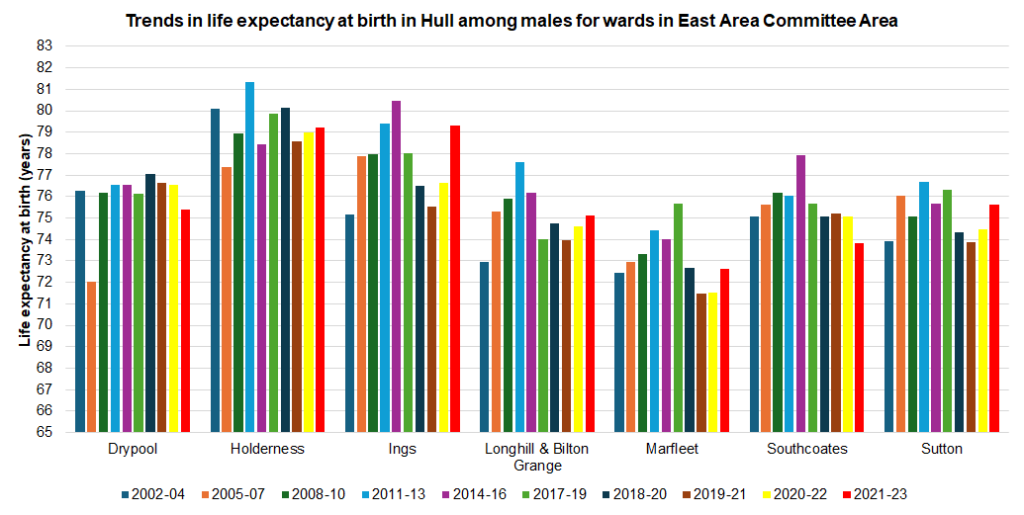
Male life expectancy decreased in the last four years from 2017-19 to 2021-23 for all wards in West Area Committee Area at least in part due to the pandemic with the largest decreases for Pickering ward.
Over the period 2002-04 to 2021-23, male life expectancy has decreased by 0.5 years in Newington & Gipsyville, and by 1.1 years in Pickering. Over the same period of time, male life expectancy increased by 2.9 years in Pickering, by 1.5 years in Derringham, and by 2.6 years in St Andrew’s & Docklands. Overall in West Area Committee Area, male life expectancy has increased by 0.8 years from 73.8 years in 2002-04 to 74.5 years in 2021-23 representing an increase of 1.0%.
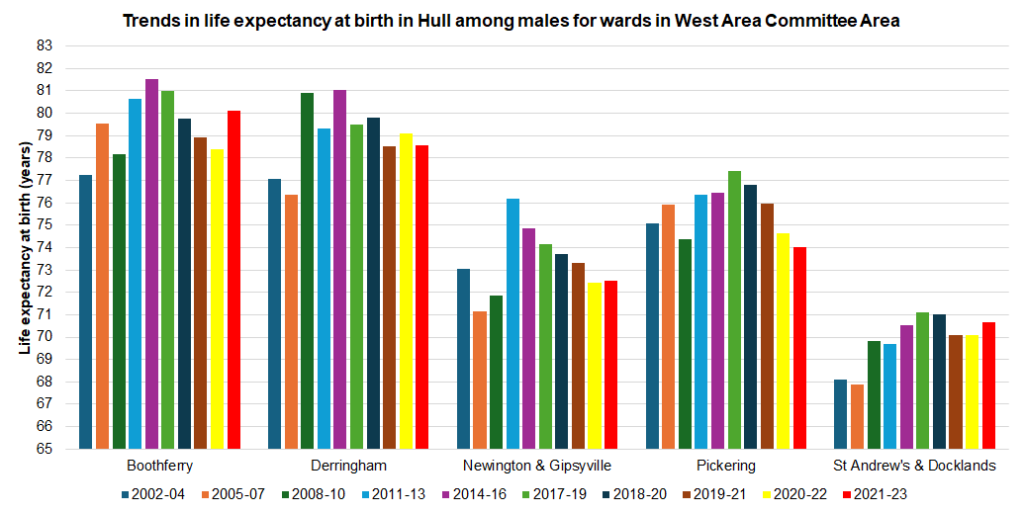
In general, the difference in male life expectancy at birth has been around one year among the three Area Committee Areas, although for some periods it has been narrower than this and other periods wider than this. Male life expectancy at birth has been consistently lower in West Area Committee Area.
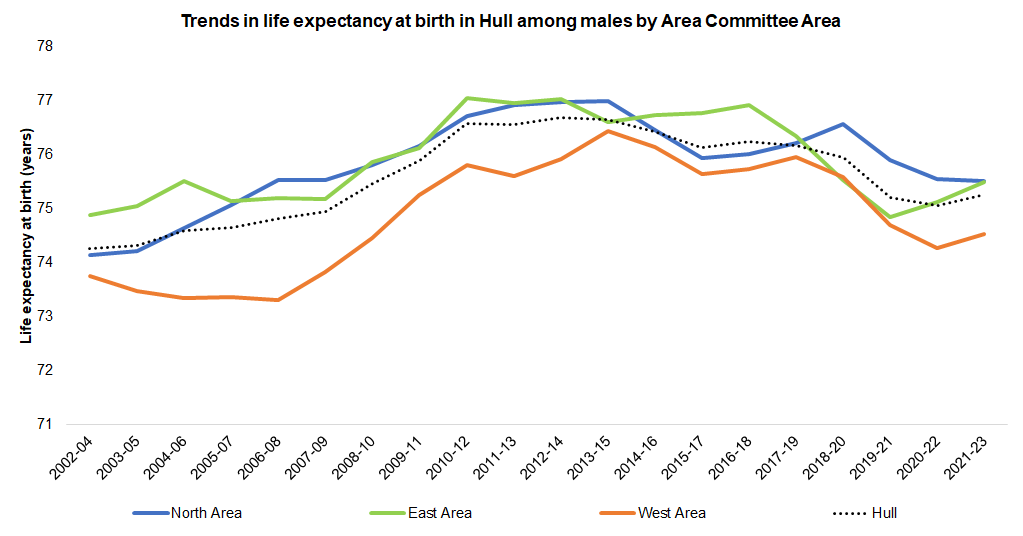
For 2021-23, female life expectancy at birth varied between 75. 9 years in Central to 84.6 years in Kingswood.
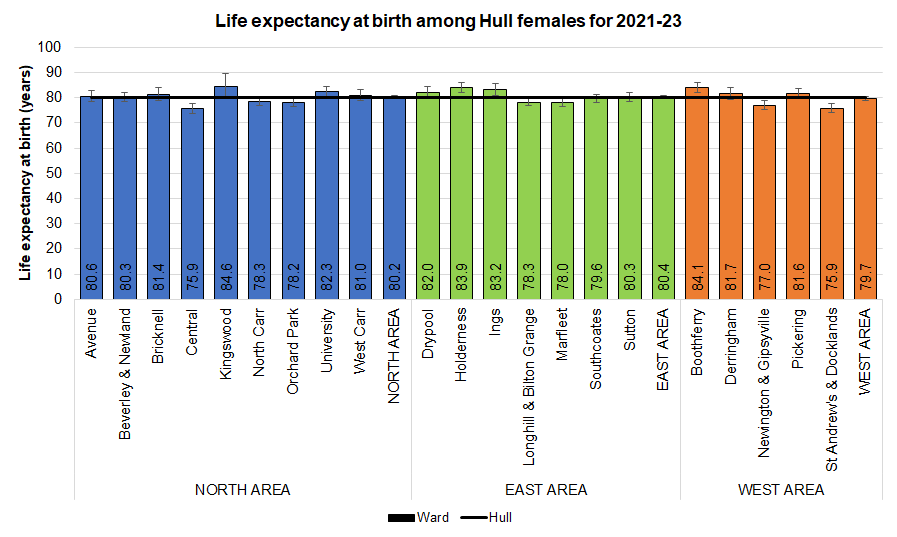
For females, living in North Area Committee Area, life expectancy has decreased for the majority of wards in the last four years partly due to the pandemic with the largest decreases in Beverley & Newland and Central wards.
Between 2002-04 and 2021-23, female life expectancy has decreased by 0.2 years in Beverley & Newland, by 0.3 years in Central, by 2.7 years in Orchard Park, and by 1.8 years in West Carr. Over the same period, female life expectancy remained the same in Avenue, and increased by 1.3 years in Bricknell, by 2.0 years in North Carr and by 2.6 years in University. The total population in Kingswood ward between 2002-04 and 2007-09 was too low for life expectancy calculations to be valid (fewer than 5,000 residents) so are not shown, and the figures are more variable for this ward due to the population size and its younger population with fewer deaths. Overall in North Area Committee Area, female life expectancy has increased by 0.9 years from 79.3 years in 2002-04 to 80.2 years in 2021-23 representing an increase of 1.1%.
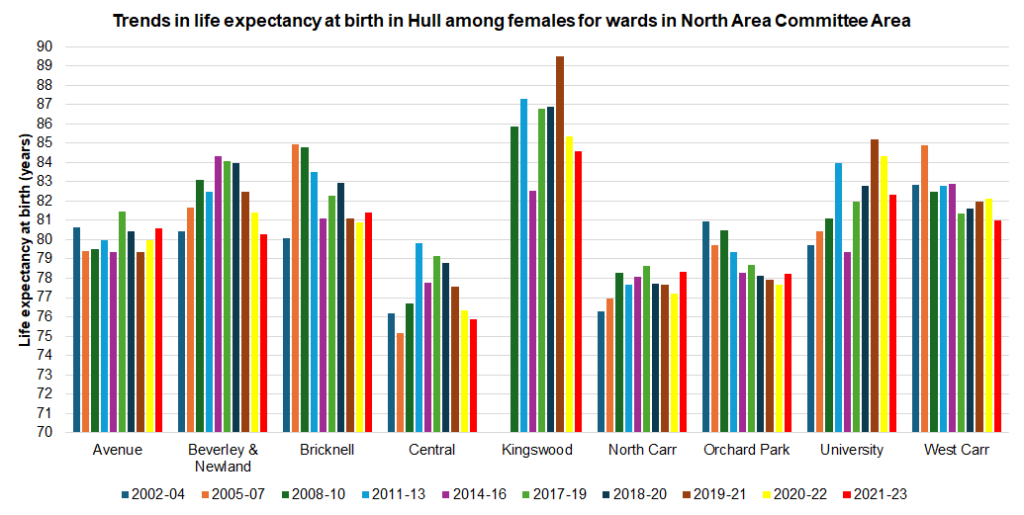
Within East Area Committee, between 2002-04 and 2021-23, female life expectancy has decreased by 1.6 years in Marfleet. Over the same period of time, it remained the same in Longhill & Bilton Grange, and increased by 4.6 years in Drypool, by 3.6 years in Holderness, by 3.1 years in Ings, by 0.1 years in Southcoates, and by 2.6 years in Sutton. Overall in East Area Committee Area, female life expectancy has increased by 1.5 years from 78.9 years in 2002-04 to 80.4 years in 2021-23 representing an increase of 1.9%.
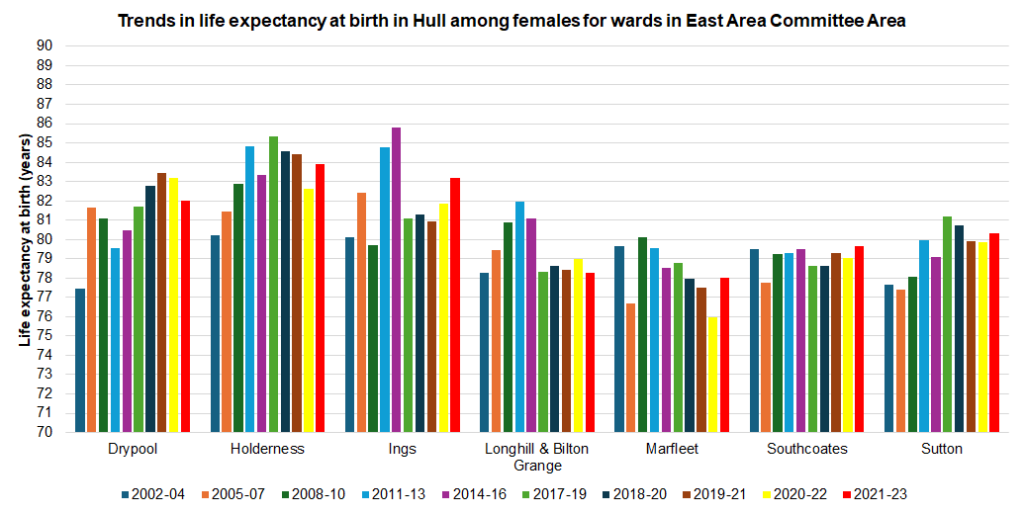
Within West Area Committee, between 2002-04 and 2021-23, female life expectancy has decreased by 1.1 years in Derringham, and by 1.1 years in Newington & Gipsyville. Over the same period, female life expectancy has increased by 1.1 years in Boothferry, by 4.8 years in Pickering, and by 0.9 years in St Andrew’s & Docklands. Overall in West Area Committee Area, female life expectancy has increased by 0.7 years from 79.0 years in 2002-04 to 79.7 years in 2021-23 representing an increase of 0.9%.
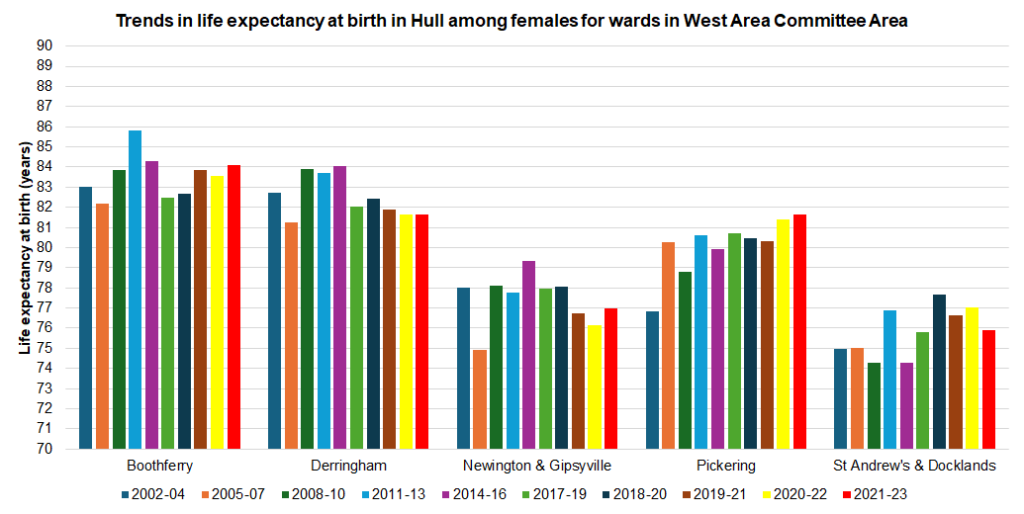
In general, the inequalities gap in female life expectancy at birth among the three Areas has decreased over time as it was just over one year between 2003-05 and 2009-11, but is 0.6 years for 2021-23. Female life expectancy at birth has been consistently lower in West Area Committee Area.
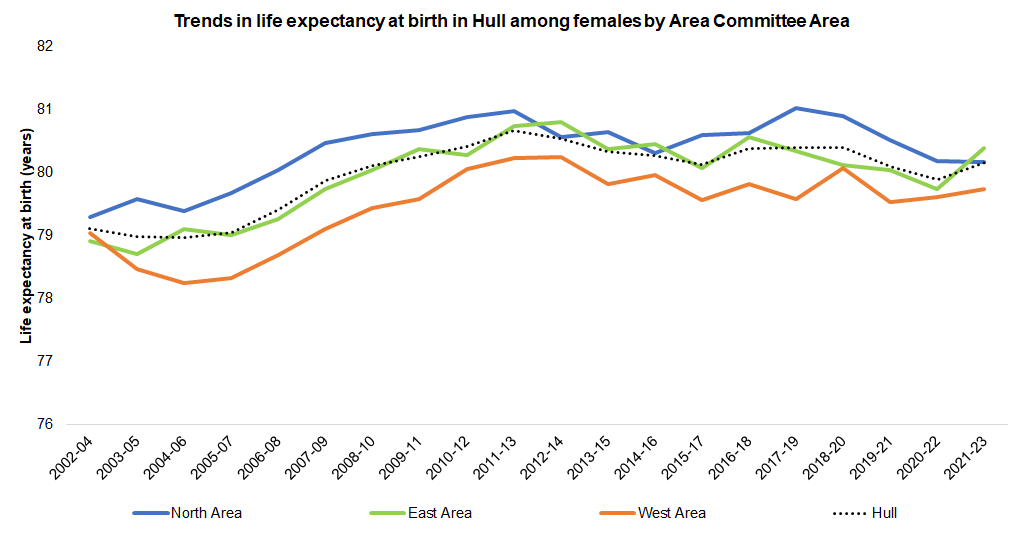
Healthy Life Expectancy At Birth
Healthy life expectancy is a measure of the average number of years a person would expect to live in good health based on contemporary mortality rates and prevalence of self-reported ‘good’ health. Healthy life expectancy is lower in Hull compared to England, and furthermore, when comparing life expectancy and healthy life expectancy, people in Hull live a shorter time in good health.
Healthy life expectancy at birth is 54.3 years for men and 59.3 years for women in Hull for 2021-23. This is 7.2 years for men and 7.3 years for women lower than England
Compared with benchmark
| Indicator | Period | England | Yorkshire and the Humber region (statistical) | Kingston upon Hull | East Riding of Yorkshire | North East Lincolnshire | North Lincolnshire | York | North Yorkshire UA | Barnsley | Doncaster | Rotherham | Sheffield | Bradford | Calderdale | Kirklees | Leeds | Wakefield |
|---|---|---|---|---|---|---|---|---|---|---|---|---|---|---|---|---|---|---|
Healthy life expectancy at birth (Male All ages) | 2021 - 23 | 61.5 | 58.8 | 54.3 | 61.3 | 54.7 | 60.4 | 62.0 | 63.8 | 52.9 | 57.3 | 56.0 | 58.1 | 57.5 | 61.9 | 58.7 | 60.7 | 55.7 |
Healthy life expectancy at birth (Female All ages) | 2021 - 23 | 61.9 | 59.3 | 54.6 | 61.6 | 54.3 | 61.6 | 62.7 | 64.6 | 52.6 | 57.7 | 55.6 | 58.1 | 58.1 | 63.2 | 58.9 | 61.5 | 55.8 |
| Indicator | Period | England | Yorkshire and the Humber region (statistical) | Kingston upon Hull | East Riding of Yorkshire | North East Lincolnshire | North Lincolnshire | York | North Yorkshire UA | Barnsley | Doncaster | Rotherham | Sheffield | Bradford | Calderdale | Kirklees | Leeds | Wakefield |
|---|---|---|---|---|---|---|---|---|---|---|---|---|---|---|---|---|---|---|
Healthy life expectancy at birth (Male All ages) | 2021 - 23 | 61.5 | 58.8 | 54.3 | 61.3 | 54.7 | 60.4 | 62.0 | 63.8 | 52.9 | 57.3 | 56.0 | 58.1 | 57.5 | 61.9 | 58.7 | 60.7 | 55.7 |
Healthy life expectancy at birth (Female All ages) | 2021 - 23 | 61.9 | 59.3 | 54.6 | 61.6 | 54.3 | 61.6 | 62.7 | 64.6 | 52.6 | 57.7 | 55.6 | 58.1 | 58.1 | 63.2 | 58.9 | 61.5 | 55.8 |
Examining trends over time show that healthy life expectancy at birth has remained relatively static with more apparent changes in the last couple of years.
Between 2011-13 and 2017-19, healthy life expectancy among Hull men increased slightly from 56.3 to 57.8 years, but decreased to a low of 53.8 years for 2020-22. There has been a slight recovery to 54.3 years for 2021-22 as the excess deaths (mainly from COVID-19) from the year 2020 are no longer included. Nevertheless, in the last ten years, healthy life expectancy among Hull men has reduced by 2.0 years representing a decrease of 3.6%.
Over the same period, male healthy life expectancy has decreased by 2.1 years across the region (-3.6%) and by 1.5 years for England (-2.4%). Over the entire period, the inequalities gap between Hull and England has increased.
Compared with benchmark
Healthy life expectancy at birth (Male All ages)
|
Period
|
Kingston upon Hull |
Yorkshire and the Humber region (statistical)
|
England
|
||||
|---|---|---|---|---|---|---|---|
|
Count
|
Value
|
95%
Lower CI |
95%
Upper CI |
||||
| 2011 - 13 | • | - | 56.3 | 54.0 | 58.7 | 60.9 | 63.0 |
| 2012 - 14 | • | - | 56.3 | 53.8 | 58.8 | 61.0 | 63.2 |
| 2013 - 15 | • | - | 56.4 | 53.9 | 58.9 | 61.3 | 63.2 |
| 2014 - 16 | • | - | 56.2 | 53.6 | 58.7 | 61.0 | 63.3 |
| 2015 - 17 | • | - | 57.3 | 54.9 | 59.6 | 61.5 | 63.3 |
| 2016 - 18 | • | - | 56.9 | 54.5 | 59.4 | 61.2 | 63.3 |
| 2017 - 19 | • | - | 57.8 | 55.2 | 60.3 | 61.2 | 63.2 |
| 2018 - 20 | • | - | 56.1 | 53.0 | 59.1 | 61.2 | 63.1 |
| 2019 - 21 | • | - | 55.7 | 51.9 | 59.4 | 60.5 | 62.7 |
| 2020 - 22 | • | - | 53.8 | 50.3 | 57.4 | 60.1 | 62.3 |
| 2021 - 23 | • | - | 54.3 | 50.2 | 58.4 | 58.8 | 61.5 |
Source: Office for National Statistics
Healthy life expectancy increased among women between 2011-13 and 2017-19 by 1.5 years, but has since fallen to a low of 53.2 years for 2020-22, although as for men, the female healthy life expectancy has recovered to 54.6 years for 2021-23. Despite the increase in the last year, over the entire ten year period, healthy life expectancy among Hull women has reduced by 2.4 years representing a decrease of 4.2%.
Over the same period, female healthy life expectancy has decreased by 2.3 years across the region (-3.7%) and by 2.0 years for England (-3.1%).
Compared with benchmark
Healthy life expectancy at birth (Female All ages)
|
Period
|
Kingston upon Hull |
Yorkshire and the Humber region (statistical)
|
England
|
||||
|---|---|---|---|---|---|---|---|
|
Count
|
Value
|
95%
Lower CI |
95%
Upper CI |
||||
| 2011 - 13 | • | - | 57.0 | 54.6 | 59.3 | 61.6 | 63.9 |
| 2012 - 14 | • | - | 56.7 | 54.3 | 59.1 | 61.7 | 63.9 |
| 2013 - 15 | • | - | 56.6 | 54.1 | 59.0 | 61.9 | 64.2 |
| 2014 - 16 | • | - | 56.5 | 53.9 | 59.1 | 61.7 | 64.1 |
| 2015 - 17 | • | - | 57.2 | 54.4 | 59.9 | 61.7 | 64.0 |
| 2016 - 18 | • | - | 57.7 | 54.7 | 60.7 | 62.1 | 64.1 |
| 2017 - 19 | • | - | 58.5 | 55.4 | 61.6 | 62.0 | 63.7 |
| 2018 - 20 | • | - | 56.5 | 53.0 | 60.0 | 62.0 | 64.0 |
| 2019 - 21 | • | - | 56.0 | 52.3 | 59.6 | 61.0 | 63.7 |
| 2020 - 22 | • | - | 53.2 | 49.4 | 57.1 | 60.1 | 62.8 |
| 2021 - 23 | • | - | 54.6 | 50.5 | 58.7 | 59.3 | 61.9 |
Source: Office for National Statistics
It is possible to examine the life expectancy and healthy life expectancy, to estimate the number of years a person will live in ‘not good’ health.
For 2021-23, male healthy life expectancy is 54.3 years and life expectancy at birth is 75.3 years, so it is estimated that men spend 21.0 years of their life not in ‘good’ health which represents 27.9% of their lives (17.6 years for England representing 22.2%). For women, healthy life expectancy was 54.6 years and life expectancy at birth was 80.2 years, so it is estimated that women spend 25.6 years of their life not in ‘good’ health representing 31.9% of their lives (21.2 years for England representing 25.5%).
Life Expectancy at Age 65 Years
Life expectancy estimates are also available at age 65 years. Contemporary mortality rates will be more comparable to the actual mortality rates in future over the next 15-20 years, so life expectancy at age 65 years will be a more accurate estimate of the additional life expectancy or duration of life among those currently aged 65 years.
Life expectancy at aged 65 years is 16.7 years for men and 19.1 years for women in Hull for 2021-23. Both of these are two years lower than for England.
Compared with benchmark
| Indicator | Period | England | Yorkshire and the Humber region (statistical) | Kingston upon Hull | East Riding of Yorkshire | North East Lincolnshire | North Lincolnshire | York | North Yorkshire UA | Barnsley | Doncaster | Rotherham | Sheffield | Bradford | Calderdale | Kirklees | Leeds | Wakefield |
|---|---|---|---|---|---|---|---|---|---|---|---|---|---|---|---|---|---|---|
Life expectancy at 65 (Male 65) | 2021 - 23 | 18.7 | 18.3 | 16.7 | 18.8 | 17.9 | 18.2 | 19.0 | 19.6 | 17.5 | 17.7 | 18.2 | 18.2 | 17.7 | 18.1 | 18.2 | 18.1 | 18.0 |
Life expectancy at 65 (Female 65) | 2021 - 23 | 21.1 | 20.6 | 19.1 | 21.3 | 19.9 | 21.0 | 21.6 | 21.9 | 19.6 | 20.0 | 19.8 | 20.4 | 20.2 | 20.5 | 20.5 | 20.8 | 19.9 |
| Indicator | Period | England | Yorkshire and the Humber region (statistical) | Kingston upon Hull | East Riding of Yorkshire | North East Lincolnshire | North Lincolnshire | York | North Yorkshire UA | Barnsley | Doncaster | Rotherham | Sheffield | Bradford | Calderdale | Kirklees | Leeds | Wakefield |
|---|---|---|---|---|---|---|---|---|---|---|---|---|---|---|---|---|---|---|
Life expectancy at 65 (Male 65) | 2021 - 23 | 18.7 | 18.3 | 16.7 | 18.8 | 17.9 | 18.2 | 19.0 | 19.6 | 17.5 | 17.7 | 18.2 | 18.2 | 17.7 | 18.1 | 18.2 | 18.1 | 18.0 |
Life expectancy at 65 (Female 65) | 2021 - 23 | 21.1 | 20.6 | 19.1 | 21.3 | 19.9 | 21.0 | 21.6 | 21.9 | 19.6 | 20.0 | 19.8 | 20.4 | 20.2 | 20.5 | 20.5 | 20.8 | 19.9 |
Life expectancy among Hull men at the age of 65 years gradually increased from 15.2 years in 2001-03 to a high of 16.8 years in 2012-14 decreasing slightly to 16.6 years in 2017-19 prior to the pandemic. Male life expectancy fell to 16.2 years for 2019-21 but has increased slightly in the last two years and is now 0.1 years higher than pre-pandemic levels.
Between 2001-03 and 2021-23, male life expectancy at age 65 years has increased by 10% although across both the region and England the increase has been 15%.
Compared with benchmark
Life expectancy at 65 (Male 65)
|
Period
|
Kingston upon Hull |
Yorkshire and the Humber region (statistical)
|
England
|
||||
|---|---|---|---|---|---|---|---|
|
Count
|
Value
|
95%
Lower CI |
95%
Upper CI |
||||
| 2001 - 03 | • | - | 15.2 | 14.9 | 15.5 | 15.9 | 16.3 |
| 2002 - 04 | • | - | 15.4 | 15.1 | 15.7 | 16.1 | 16.5 |
| 2003 - 05 | • | - | 15.5 | 15.2 | 15.8 | 16.4 | 16.8 |
| 2004 - 06 | • | - | 15.7 | 15.4 | 16.0 | 16.7 | 17.1 |
| 2005 - 07 | • | - | 15.8 | 15.5 | 16.1 | 16.9 | 17.3 |
| 2006 - 08 | • | - | 15.9 | 15.6 | 16.2 | 17.1 | 17.5 |
| 2007 - 09 | • | - | 16.0 | 15.6 | 16.3 | 17.3 | 17.7 |
| 2008 - 10 | • | - | 16.3 | 16.0 | 16.6 | 17.4 | 18.0 |
| 2009 - 11 | • | - | 16.4 | 16.1 | 16.8 | 17.7 | 18.2 |
| 2010 - 12 | • | - | 16.8 | 16.5 | 17.1 | 17.9 | 18.4 |
| 2011 - 13 | • | - | 16.8 | 16.5 | 17.1 | 17.9 | 18.5 |
| 2012 - 14 | • | - | 16.8 | 16.5 | 17.1 | 18.1 | 18.6 |
| 2013 - 15 | • | - | 16.7 | 16.4 | 17.0 | 18.1 | 18.6 |
| 2014 - 16 | • | - | 16.6 | 16.3 | 16.9 | 18.2 | 18.7 |
| 2015 - 17 | • | - | 16.5 | 16.2 | 16.8 | 18.2 | 18.7 |
| 2016 - 18 | • | - | 16.6 | 16.3 | 16.8 | 18.2 | 18.8 |
| 2017 - 19 | • | - | 16.6 | 16.3 | 16.8 | 18.3 | 18.9 |
| 2018 - 20 | • | - | 16.4 | 16.1 | 16.6 | 18.1 | 18.6 |
| 2019 - 21 | • | - | 16.2 | 15.9 | 16.5 | 18.0 | 18.5 |
| 2020 - 22 | • | - | 16.4 | 16.1 | 16.6 | 17.9 | 18.4 |
| 2021 - 23 | • | - | 16.7 | 16.4 | 17.0 | 18.3 | 18.7 |
Source: Office for National Statistics
Among Hull women, life expectancy at age 65 years increased from 18.1 years in 2001-03 to a high of 19.3 years in 2011-13, followed by a decrease to 19.0 years for 2017-19 prior to the pandemic. Female life expectancy at age 65 years decreased to 18.8 years for 2020-22, but has increased in the last year to 19.1 years which is 0.1 years higher than pre-pandemic levels.
Over the entire period, 2001-03 to 2020-22, life expectancy at age 65 years has increased by 5% for Hull compared to 9% across the region and 10% for England.
Compared with benchmark
Life expectancy at 65 (Female 65)
|
Period
|
Kingston upon Hull |
Yorkshire and the Humber region (statistical)
|
England
|
||||
|---|---|---|---|---|---|---|---|
|
Count
|
Value
|
95%
Lower CI |
95%
Upper CI |
||||
| 2001 - 03 | • | - | 18.1 | 17.9 | 18.4 | 18.9 | 19.2 |
| 2002 - 04 | • | - | 18.0 | 17.7 | 18.3 | 19.0 | 19.4 |
| 2003 - 05 | • | - | 18.1 | 17.8 | 18.4 | 19.2 | 19.6 |
| 2004 - 06 | • | - | 18.3 | 18.0 | 18.6 | 19.5 | 19.9 |
| 2005 - 07 | • | - | 18.3 | 18.0 | 18.6 | 19.6 | 20.0 |
| 2006 - 08 | • | - | 18.5 | 18.2 | 18.8 | 19.7 | 20.2 |
| 2007 - 09 | • | - | 18.8 | 18.5 | 19.1 | 19.8 | 20.3 |
| 2008 - 10 | • | - | 19.1 | 18.8 | 19.4 | 20.1 | 20.5 |
| 2009 - 11 | • | - | 19.3 | 19.0 | 19.6 | 20.3 | 20.9 |
| 2010 - 12 | • | - | 19.3 | 19.0 | 19.6 | 20.4 | 20.9 |
| 2011 - 13 | • | - | 19.3 | 19.0 | 19.6 | 20.4 | 21.0 |
| 2012 - 14 | • | - | 19.2 | 18.9 | 19.5 | 20.5 | 21.1 |
| 2013 - 15 | • | - | 19.0 | 18.7 | 19.3 | 20.5 | 21.1 |
| 2014 - 16 | • | - | 19.0 | 18.7 | 19.3 | 20.6 | 21.1 |
| 2015 - 17 | • | - | 18.9 | 18.7 | 19.2 | 20.5 | 21.0 |
| 2016 - 18 | • | - | 19.0 | 18.7 | 19.3 | 20.6 | 21.1 |
| 2017 - 19 | • | - | 19.0 | 18.7 | 19.3 | 20.6 | 21.2 |
| 2018 - 20 | • | - | 19.0 | 18.7 | 19.3 | 20.4 | 21.0 |
| 2019 - 21 | • | - | 19.0 | 18.7 | 19.3 | 20.4 | 21.0 |
| 2020 - 22 | • | - | 18.8 | 18.6 | 19.1 | 20.4 | 20.9 |
| 2021 - 23 | • | - | 19.1 | 18.8 | 19.4 | 20.6 | 21.1 |
Source: Office for National Statistics
Life Expectancy at Age 65 Years Among Local Deprivation Groups
Life expectancy at age 65 differs among the local deprivation tenths and fifths defined on the basis of the Index of Multiple Deprivation 2019. The 95% confidence intervals are shown (for more information see Confidence Intervals in the Glossary).
In order for the life expectancy calculations to be statistically valid, the total population needs to be 5,000 or more. If the population is fewer than 5,000 residents, then the life expectancy calculation needs to be based on more years of data, and this is particularly the case when examining life expectancy at age 65 years as the population aged 65+ years is much smaller than the total population. To examine differences in the local deprivation fifths and tenths, five years of data has been combined.
For the period 2019-23, there is a statistically significant trend in male life expectancy at age 65 years over the local deprivation tenths with a difference in 5.2 years between males living in the most deprived tenth of areas of Hull compared to males living in the least deprived tenth of areas of Hull (although the differences between the tenths is 6.0 years as the third least deprived tenth has the highest male life expectancy at age 65 years).
A magnitude of the difference is relatively large given that male life expectancy at age 65 years is 13.9 years for the most deprived tenth. This means that life expectancy at age 65 years is 38% higher among men living in the least deprived tenth compared to the most deprived tenth of areas of Hull.
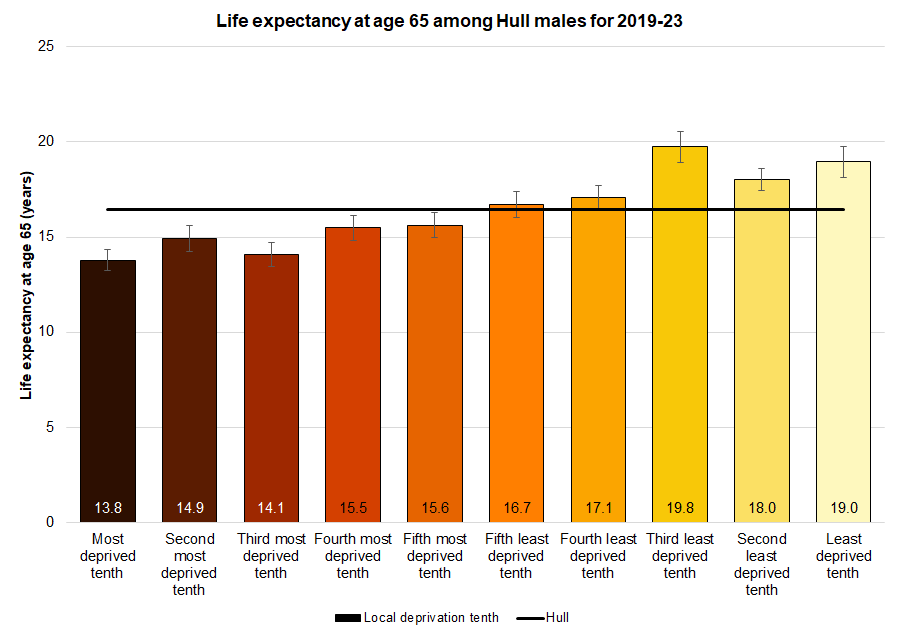
There is a four year inequalities gap in male male life expectancy at age 65 years with a life expectancy of 14.3 years for men living in the most deprived tenth of areas of Hull compared to 18.3 years for men living in the least deprived tenth of areas of Hull.
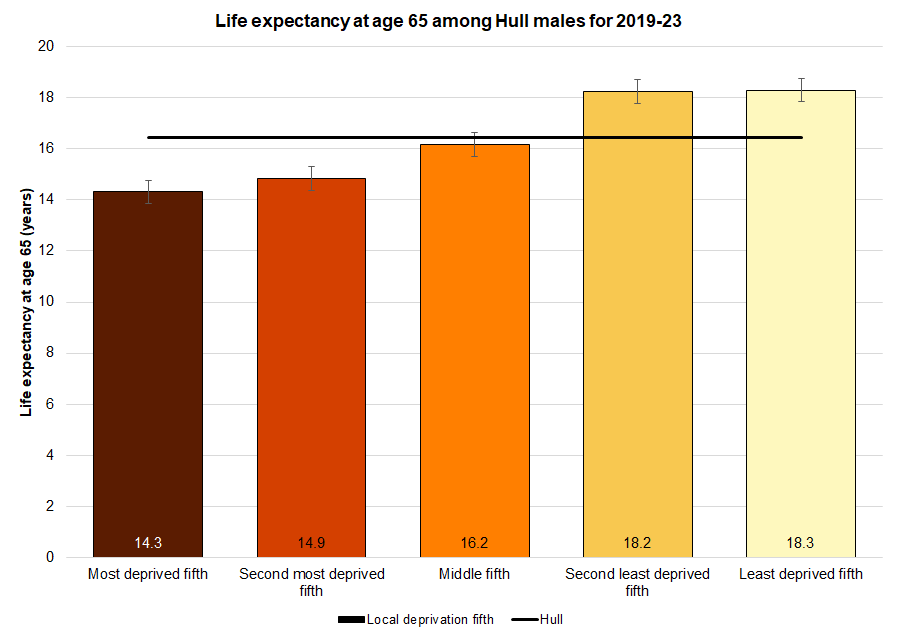
Between 2002-06 and 2019-23, male life expectancy at age 65 years had increased by 0.5 years (3.8%) among men living in the most deprived fifth of areas of Hull, by 0.5 years (3.5%) among men living in the second most deprived fifth of areas of Hull, by 0.1 years (0.4%) among men living in the middle fifth of deprived areas of Hull, by 1.6 years (9.6%) among men living in the second least deprived fifth of areas of Hull, and by 0.9 years (5.4%) among men living in the least deprived fifth of areas of Hull.
Life expectancy at age 65 years has been consistently lower among men living in the most deprived areas of Hull.
The difference in male life expectancy at age 65 years between the most and least deprived fifths has ranged between 2.7 years and 4.0 years. The inequalities gap was 3.6 or 3.7 years for the four years 2002-06 and 2005-09, and then increased to 4.0 years for 2006-10 to 2008-12 before decreasing to a low of 2.7 years in 2012-16, but the inequalities gap has increased since then to 4.0 years for 2019-23.
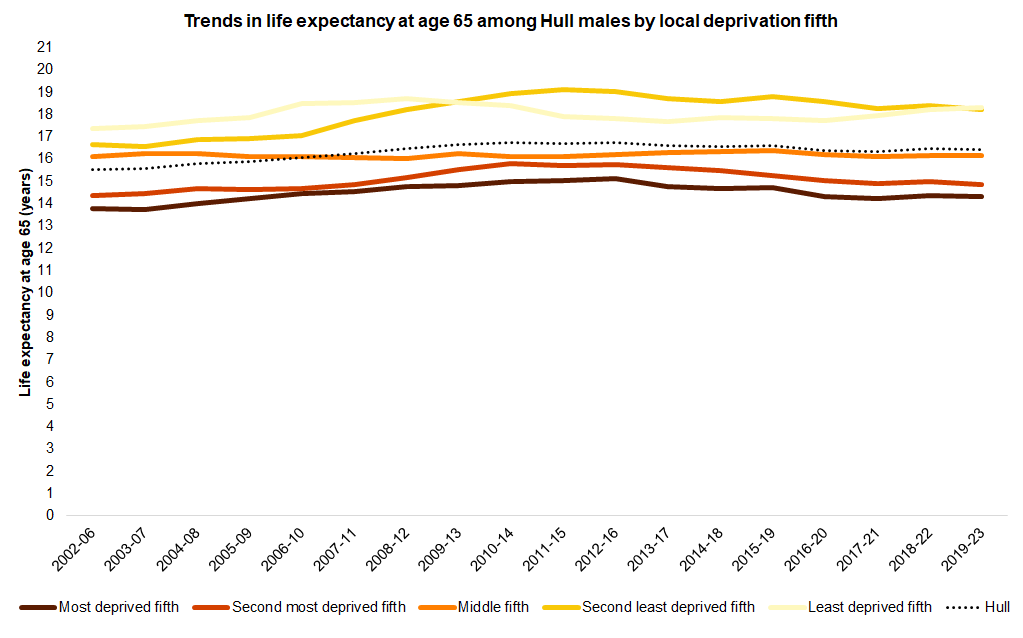
There was also a relatively large inequalities gap in female life expectancy at age 65 years across the local deprivation tenths although life expectancy is much higher for those women living in the third least deprived areas of Hull. The inequalities gap was 4.8 years between the most and least deprived tenth of areas of Hull, but there was a difference of 9.2 years across all of the tenths. The confidence intervals for the third least deprived tenth were relatively large compared to the other confidence intervals which suggest more uncertainty around the estimates.
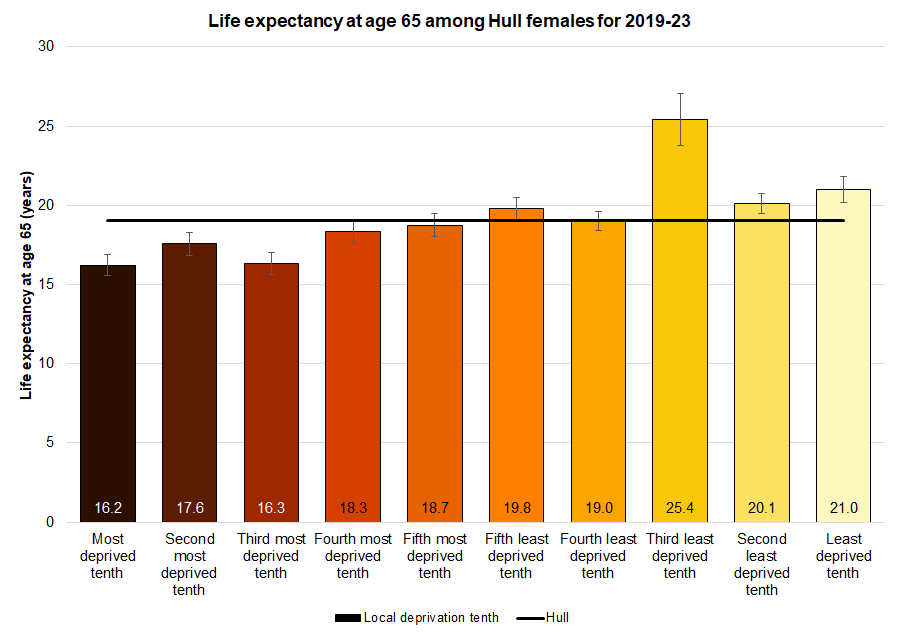
There was a 3.7 years gap in female life expectancy at age 65 years between the most and least deprived fifth of areas of Hull for 2019-23.
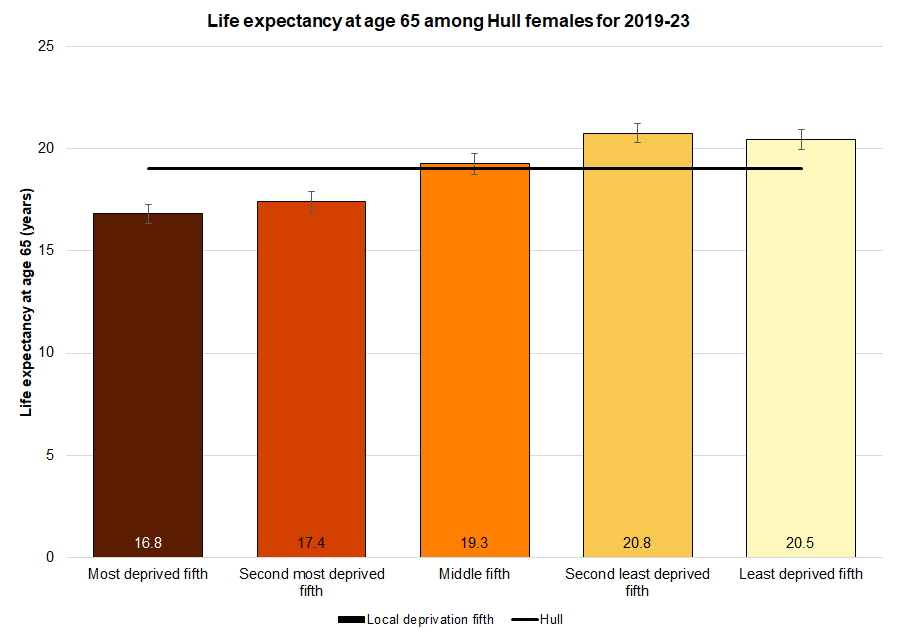
The inequalities gap for women followed a similar pattern to that for men with the highest inequalities gap between 2005-09 and 2007-11 (between 3.7 and 4.0 years) which decreased to a low of 2.9 years for 2010-14 and 2011-15 before increasing to 3.7 years for 2019-23. The latest inequalities gap is among the highest it has been since 2002-06.
Between 2002-06 and 2019-23, female life expectancy at age 65 years decreased by 0.1 years (-0.7%) for women living in the most deprived fifth of areas of Hull, but increased for the remaining four-fifths. Female life expectancy at age 65 years increased by 0.3 years (1.6%) for women living in the second most deprived fifth of areas of Hull, by 0.6 years (3.3%) for women living in the middle fifth of areas of Hull, by 1.7 years (9.0%) for women living in the second least deprived fifth of areas of Hull, and by 1.3 years (6.8%) for women living in the least deprived fifth of areas of Hull.
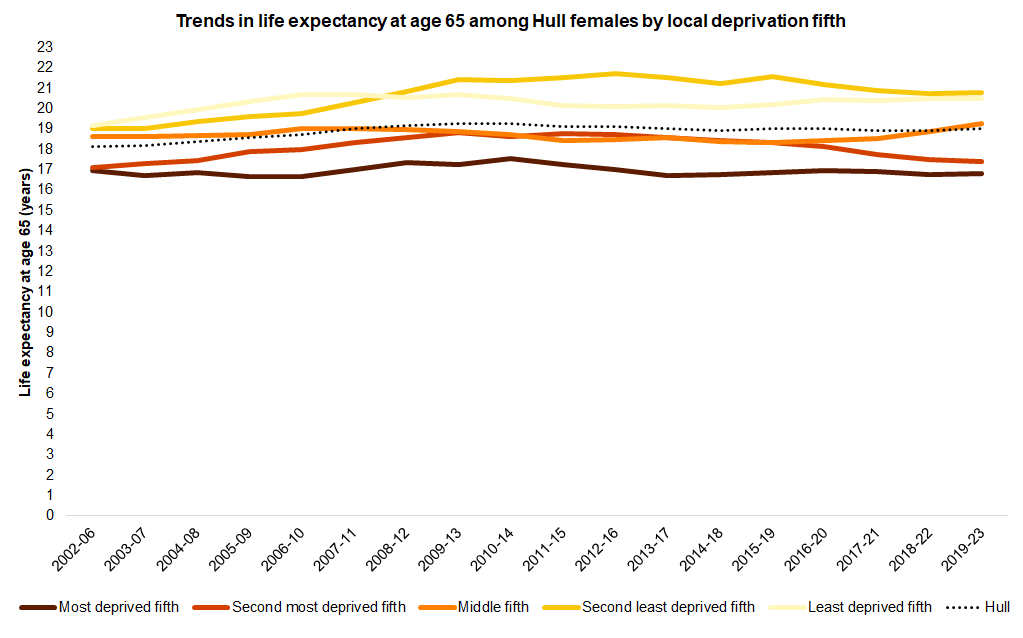
Life Expectancy at Age 65 Years Among Hull’s Wards
In order for the life expectancy calculations to be statistically valid, the total population needs to be 5,000 or more. All the wards in Hull have a total population less than 5,000 among those aged 65+ years so it is not valid to calculate life expectancy at age 65 years across Hull’s wards based on a single year, although it is possible to calculate life expectancy over a number of years to increase the population. However, even using life expectancy for 4-5 years is not sufficient. In order for most wards to have the total number of residents aged 65+ years or more, it is necessary to combine seven years of population, and even that is not sufficient for three wards. Combining seven years of population (2017 to 2023), the total male population aged 65+ years is 3,888 in Central ward, 1,257 in Kingswood ward and 4,024 in University ward, and the total female population aged 65+ years is 4,101 in Central ward, 948 in Kingswood ward and 3,473 in University ward so it is not possible to calculate life expectancy at age 65 years in these three wards for either males or females. As a result, life expectancy at age 50 years has been calculated below as the total population aged 50+ years is more than 5,000 for each of these wards for both males and females.
When linked to ward rankings based on the Index of Multiple Deprivation 2019 these inequalities tend to follow a trend of wards with the lowest deprivation ranking having some of the highest average life expectancies and wards with the highest deprivation ranking having some of the lowest life expectancies (although there were some exceptions to this trend).
Life expectancy at age 65 for 2017-23 was 0.8 years lower for men and 1.2 years lower for women for every 10 unit increase in the ward deprivation score.
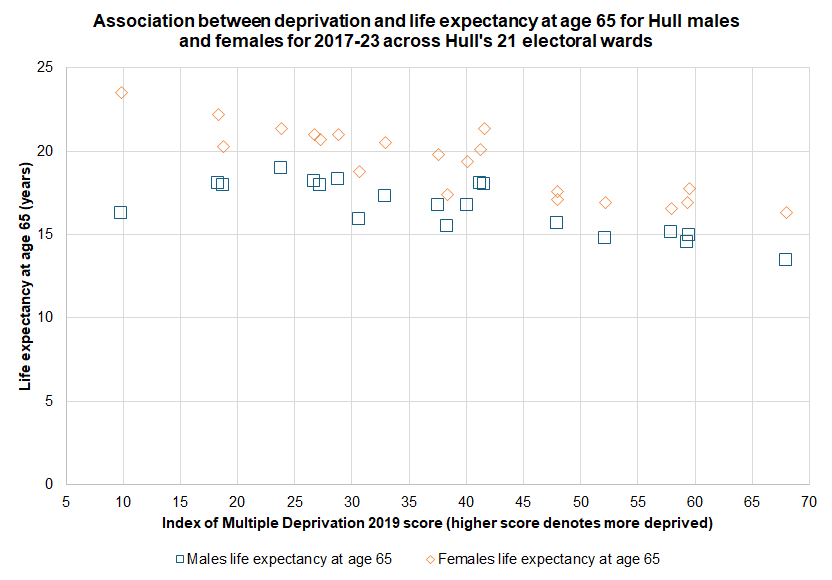
Male life expectancy at age 65 for 2017-23 varied from 13.5 years in St Andrew’s & Docklands ward to 19.0 years in Boothferry ward.
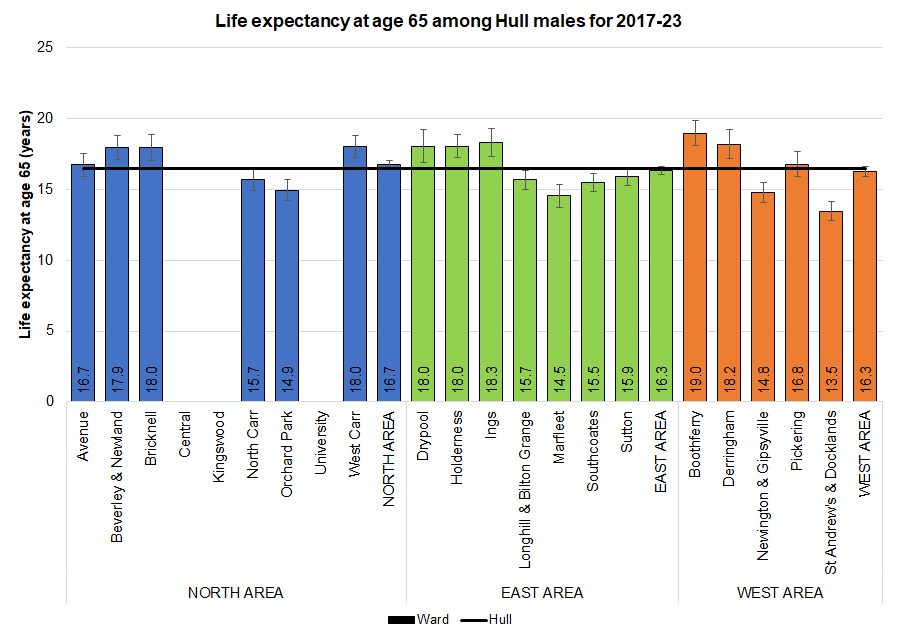
The charts below illustrate the trends in male life expectancy at age 65 across Hull’s wards for North, East and West Area Committee Areas for selected years from 2002-08 to 2012-18 and then for the last four years (rolling average).
For wards in North Area Committee Area, male life expectancy at age 65 has remained relatively constant over the last three years in Avenue, Orchard Park and West Carr, but has increased for Bricknell and North Carr, and reduced for Beverley & Newland.
Between 2002-08 and 2017-23, male life expectancy at age 65 has decreased by 1.2 years in Orchard Park, remained the same in West Carr, and increased by 0.8 years in Beverley & Newland. No trends are available for the other wards in North Area Committee Area for the entire period. Between 2012-18 and 2017-23, life expectancy at age 65 years has decreased by 0.5 years in Avenue and increased by 0.6 years in Bricknell. Between 2014-20 and 2017-23, life expectancy at age 65 years has increased by 0.4 years in North Carr.
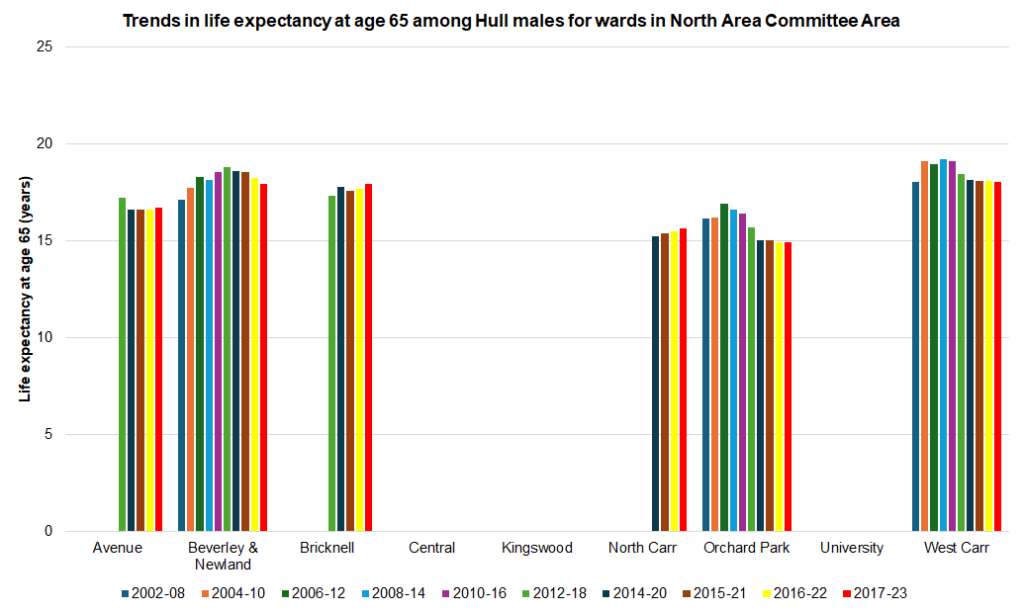
In East Area Committee Area, male life expectancy at age 65 has decreased in the last three years in Ings, Longhill & Bilton Grange, Marfleet and Southcoates, but increased in Drypool, Holderness and Sutton.
Over the period 2002-06 to 2017-23, male life expectancy at age 65 has decreased by 0.5 years in Marfleet, but increased by 1.1 years in Ings, by 0.4 years in Longhill & Bilton Grange, by 0.2 years in Southcoates and by 1.7 years in Sutton. Trends across the entire period are not available for Drypool or Holderness, but over the period 2008-14 and 2017-23, there have been increases of 0.3 years for Drypool and increases of 0.1 years for Holderness.
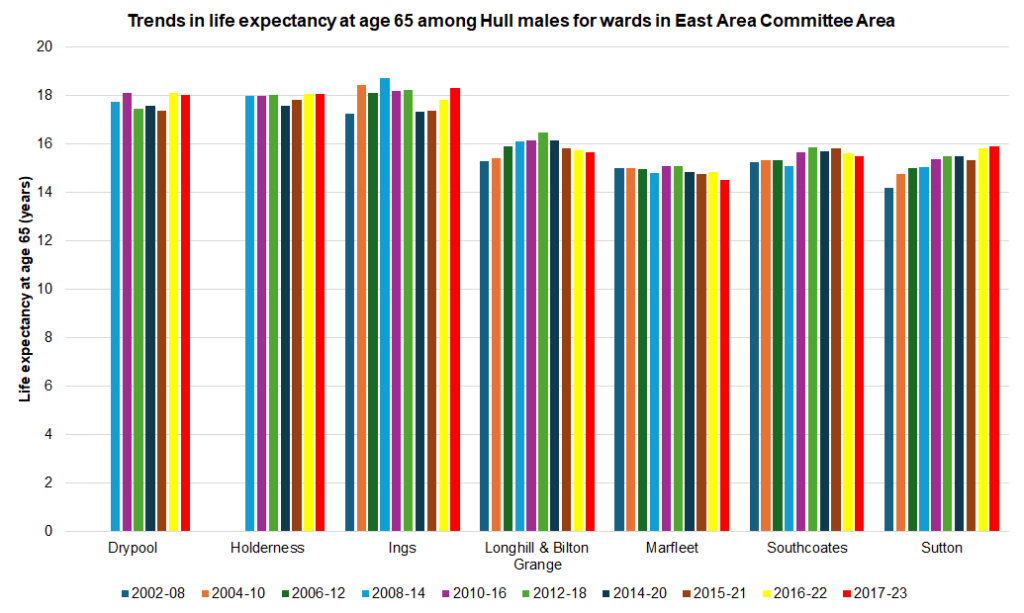
In West Area Committee Area, male life expectancy at age 65 has decreased in the last three years in Boothferry, Derringham, Newington & Gipsyville, and Pickering wards, but increased in St Andrew’s & Docklands.
Over the period 2002-06 to 2017-23, male life expectancy at age 65 has increased by 1.4 years in Boothferry, by 1.0 years in Derringham, by 1.5 years in Pickering, and by 0.9 years in St Andrew’s & Docklands. Trends across the entire period are not available for Newington & Gipsyville, but over the period 2008-14 and 2017-23, there has been a decrease of 1.3 years in Newington & Gipsyville.
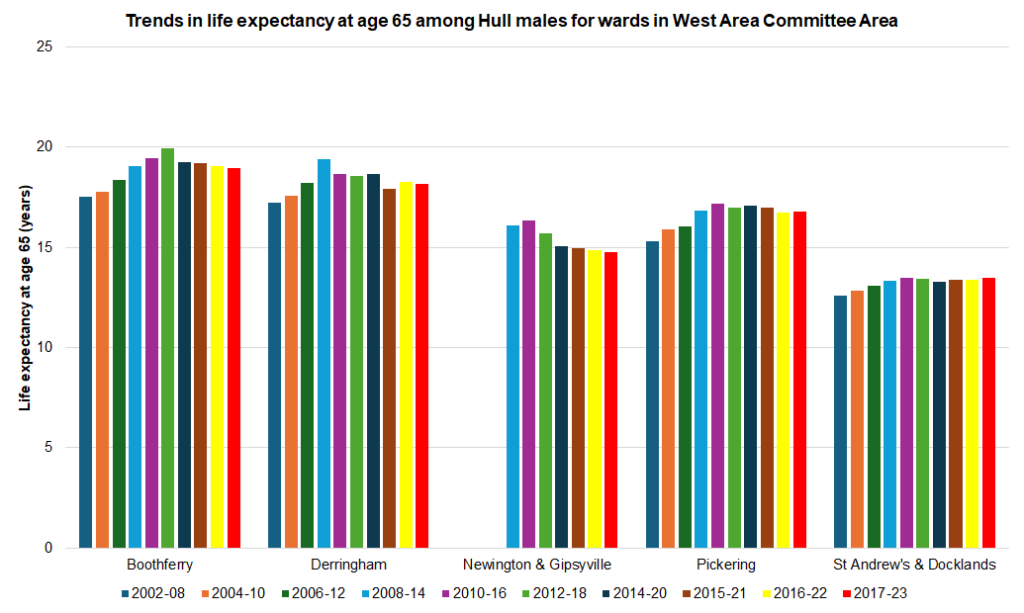
In general, the difference in male life expectancy at age 65 has varied between 0.4 years and 1.1 years for the period 2002-06 to 2019-23 among the three Area Committee Areas. Male life expectancy at age 65 has been consistently higher in North Area Committee Area.
Over the entire period 2002-06 to 2019-23, male life expectancy at age 65 years has increased by 1.0 years (+6.4%) in North, by 0.6 years (+4.0%) in East, and by 1.0 years (+6.8%) in West compared to an increase of 0.9 years (+5.8%) for Hull.
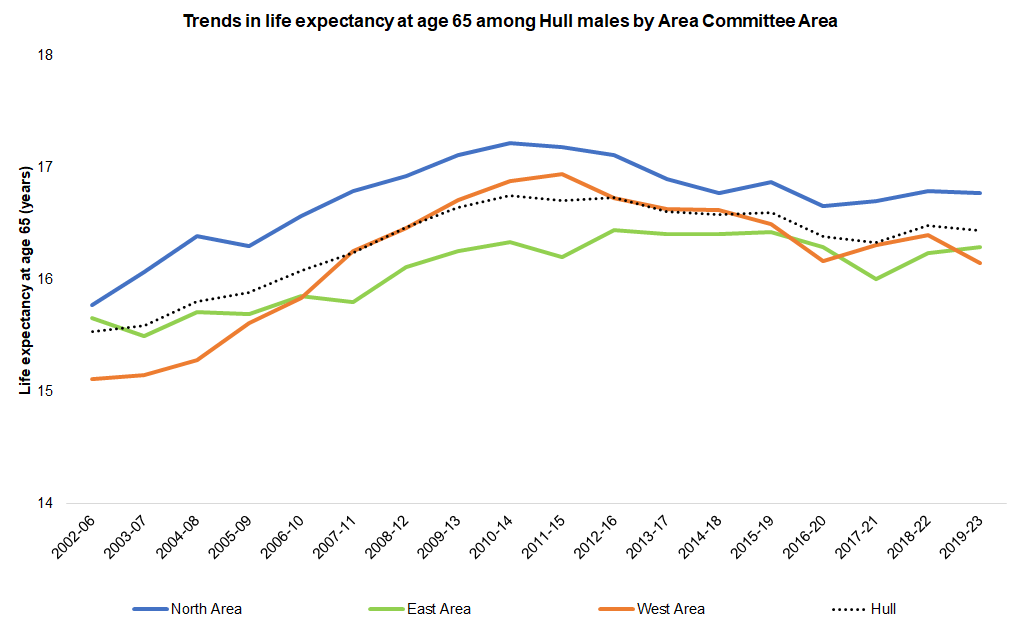
For females, life expectancy at age 65 years varied from 16.3 years in St Andrew’s & Docklands to 22.2 years in Holderness, although in Central, Kingswood and University the total population aged 65+ years was fewer than 5,000 so it was not possible to calculate life expectancy for these three wards.
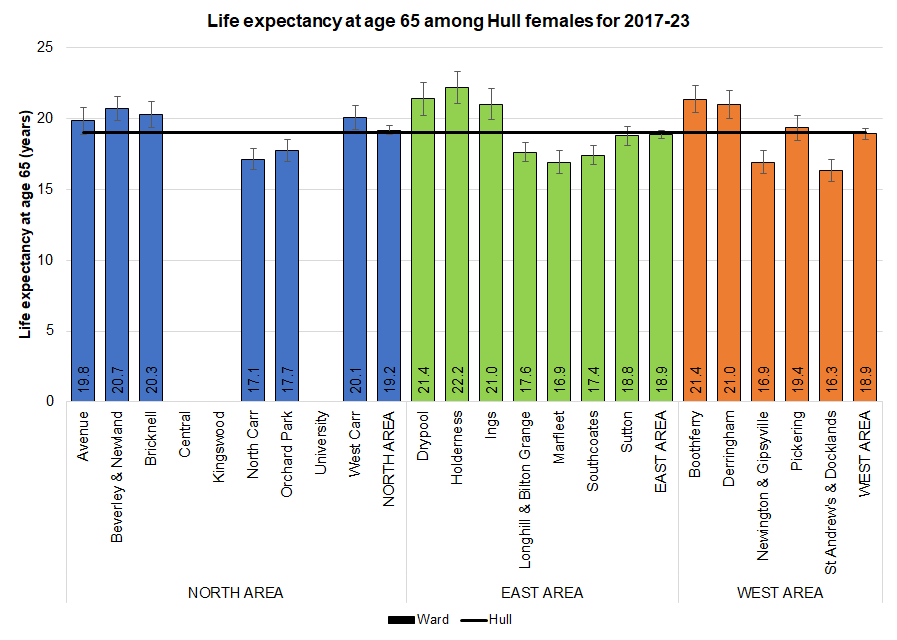
For females, living in North Area Committee Area, life expectancy at age 65 in the last three years has decreased for Beverley & Newland, North Carr, Orchard Park and West Carr, but increased for Avenue, and Bricknell.
Between 2002-08 and 2017-23, female life expectancy at age 65 has decreased by 1.9 years in Orchard Park, and by 2.9 years in West Carr. Over the same period, female life expectancy at age 65 remained the same in Bricknell, and increased by 1.5 years in Avenue, and by 1.1 years in Beverley & Newland. Trends over this entire period are not available for North Carr, but over the period 2006-12 to 2017-23, female life expectancy at age 65 increased by 0.7 years in North Carr.
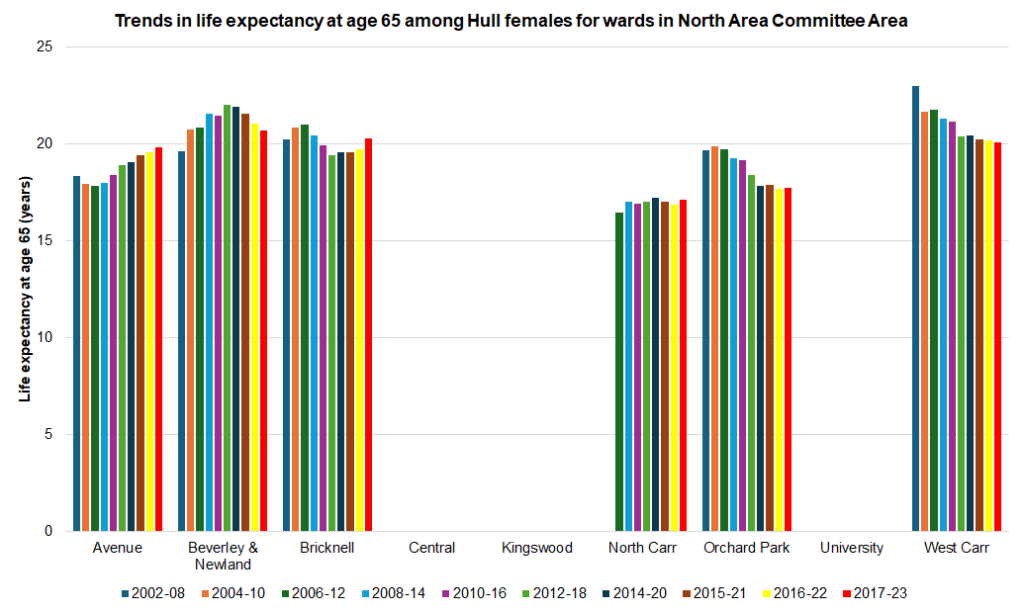
Within East Area Committee, in the last three years female life expectancy at age 65 has decreased in Drypool, Ings, Longhill & Bilton Grange, and Marfleet, and increased in Holderness and Sutton.
Between 2002-08 and 2017-23, female life expectancy at age 65 has decreased by 1.4 years in Longhill & Bilton Grange, and by 1.0 years in Marfleet. Over the same period of time, it increased by 2.5 years in Drypool, by 3.3 years in Holderness, by 1.3 years in Ings, by 0.2 years in Southcoates, and by 2.8 years in Sutton.
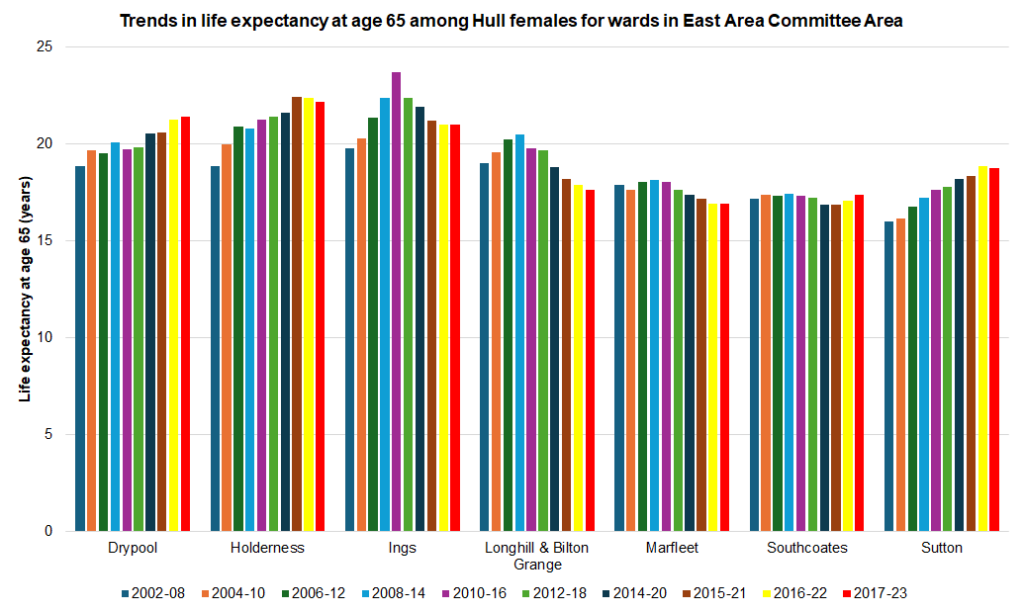
Within West Area Committee, in the last three years female life expectancy at age 65 has decreased in Boothferry, Derringham, Newington & Gipsyville, and Pickering and increased slightly in St Andrew’s & Docklands.
Between 2002-08 and 2017-23, female life expectancy at age 65 has increased by 0.2 years in Boothferry, by 0.4 years in Derringham, by 0.3 years in Newington & Gipsyville, by 1.2 years in Pickering, and by 0.3 years in St Andrew’s & Docklands.
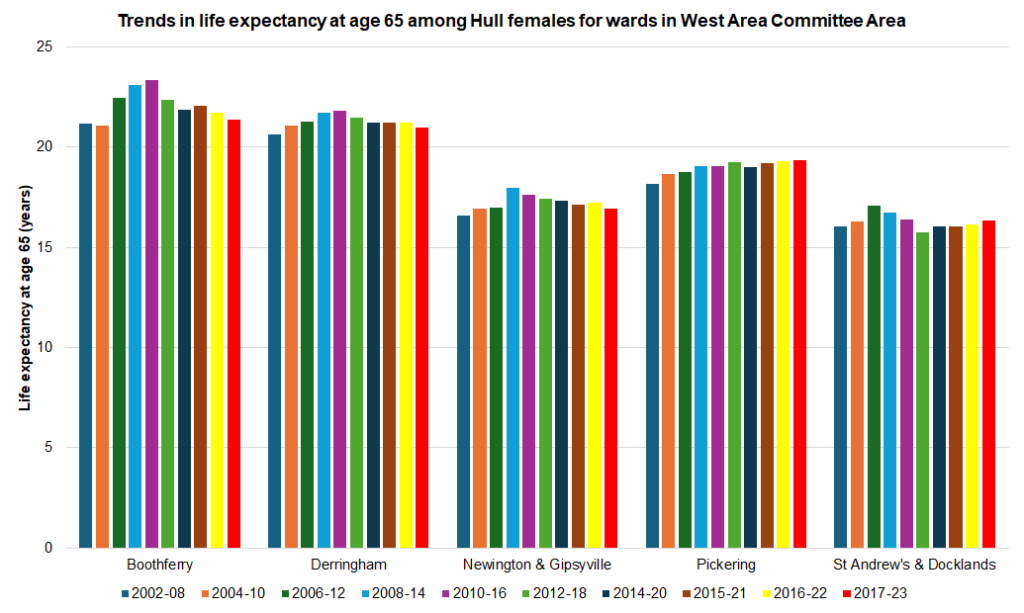
In general, the inequalities gap in female life expectancy at age 65 among the three Areas has decreased over time as it was between 0.6 and 0.8 years between 2002-06 and 2009-13, but has been between 0.4 and 0.5 years between 2015-19 and 2018-22 and is 0.2 years for the latest year 2019-23. In general, female life expectancy at age 65 has been lowest in East and highest in North.
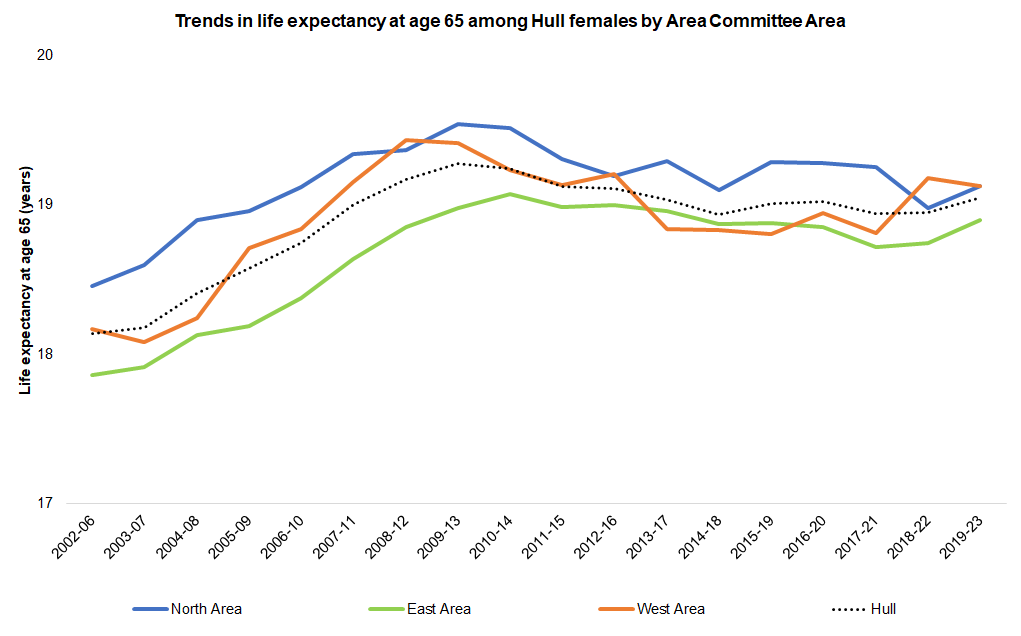
Healthy Life Expectancy At Age 65 Years
For 2021-23, healthy life expectancy at age 65 years is 7.8 years for men and 8.6 years for women in Hull which are 2.3 years and 2.6 years lower than men and women in England (both around 23% lower than England).
Compared with benchmark
| Indicator | Period | England | Yorkshire and the Humber region (statistical) | Kingston upon Hull | East Riding of Yorkshire | North East Lincolnshire | North Lincolnshire | York | North Yorkshire UA | Barnsley | Doncaster | Rotherham | Sheffield | Bradford | Calderdale | Kirklees | Leeds | Wakefield |
|---|---|---|---|---|---|---|---|---|---|---|---|---|---|---|---|---|---|---|
Healthy life expectancy at 65 (Male 65) | 2021 - 23 | 10.1 | 9.4 | 7.8 | 10.0 | 7.9 | 9.9 | 10.4 | 11.2 | 7.3 | 8.8 | 8.4 | 8.9 | 8.9 | 10.3 | 9.3 | 9.8 | 8.5 |
Healthy life expectancy at 65 (Female 65) | 2021 - 23 | 11.2 | 10.5 | 8.6 | 11.2 | 8.8 | 11.2 | 11.7 | 12.5 | 8.3 | 9.9 | 9.1 | 9.9 | 10.1 | 11.6 | 10.4 | 11.2 | 9.1 |
| Indicator | Period | England | Yorkshire and the Humber region (statistical) | Kingston upon Hull | East Riding of Yorkshire | North East Lincolnshire | North Lincolnshire | York | North Yorkshire UA | Barnsley | Doncaster | Rotherham | Sheffield | Bradford | Calderdale | Kirklees | Leeds | Wakefield |
|---|---|---|---|---|---|---|---|---|---|---|---|---|---|---|---|---|---|---|
Healthy life expectancy at 65 (Male 65) | 2021 - 23 | 10.1 | 9.4 | 7.8 | 10.0 | 7.9 | 9.9 | 10.4 | 11.2 | 7.3 | 8.8 | 8.4 | 8.9 | 8.9 | 10.3 | 9.3 | 9.8 | 8.5 |
Healthy life expectancy at 65 (Female 65) | 2021 - 23 | 11.2 | 10.5 | 8.6 | 11.2 | 8.8 | 11.2 | 11.7 | 12.5 | 8.3 | 9.9 | 9.1 | 9.9 | 10.1 | 11.6 | 10.4 | 11.2 | 9.1 |
Among men in Hull, healthy life expectancy at age 65 years increased between 2011-13 and 2017-19 from 7.5 years to 8.5 years. There has been a sharp decrease to 7.3 years for 2020-22, but an increase in the last year to 7.8 years.
The latest estimate is 0.7 years lower than the pre-pandemic estimate for Hull men.
Compared with benchmark
Healthy life expectancy at 65 (Male 65)
|
Period
|
Kingston upon Hull |
Yorkshire and the Humber region (statistical)
|
England
|
||||
|---|---|---|---|---|---|---|---|
|
Count
|
Value
|
95%
Lower CI |
95%
Upper CI |
||||
| 2011 - 13 | • | - | 7.5 | 5.9 | 9.0 | 9.2 | 10.0 |
| 2012 - 14 | • | - | 7.5 | 5.8 | 9.2 | 9.3 | 10.1 |
| 2013 - 15 | • | - | 7.4 | 5.6 | 9.1 | 9.3 | 10.2 |
| 2014 - 16 | • | - | 7.4 | 5.9 | 8.9 | 9.3 | 10.3 |
| 2015 - 17 | • | - | 8.0 | 6.6 | 9.3 | 9.6 | 10.4 |
| 2016 - 18 | • | - | 8.1 | 6.7 | 9.4 | 9.7 | 10.5 |
| 2017 - 19 | • | - | 8.5 | 7.1 | 9.8 | 9.9 | 10.5 |
| 2018 - 20 | • | - | 7.9 | 6.5 | 9.4 | 9.9 | 10.5 |
| 2019 - 21 | • | - | 8.0 | 6.6 | 9.5 | 9.9 | 10.4 |
| 2020 - 22 | • | - | 7.3 | 5.7 | 8.9 | 9.5 | 10.2 |
| 2021 - 23 | • | - | 7.8 | 6.0 | 9.6 | 9.4 | 10.1 |
Source: Office for National Statistics
Among women in Hull, healthy life expectancy at age 65 years increased between 2011-13 and 2017-19 from 8.2 years to 9.3 years. There has been a sharp decrease to 8.1 years for 2020-22, but an increase in the last year to 8.6 years.
The latest estimate is 0.7 years lower than the pre-pandemic estimate for Hull women.
Compared with benchmark
Healthy life expectancy at 65 (Female 65)
|
Period
|
Kingston upon Hull |
Yorkshire and the Humber region (statistical)
|
England
|
||||
|---|---|---|---|---|---|---|---|
|
Count
|
Value
|
95%
Lower CI |
95%
Upper CI |
||||
| 2011 - 13 | • | - | 8.2 | 6.7 | 9.7 | 10.0 | 10.8 |
| 2012 - 14 | • | - | 8.4 | 6.8 | 9.9 | 10.2 | 11.0 |
| 2013 - 15 | • | - | 8.4 | 6.9 | 10.0 | 10.4 | 11.1 |
| 2014 - 16 | • | - | 8.3 | 6.7 | 9.9 | 10.2 | 11.3 |
| 2015 - 17 | • | - | 8.8 | 7.0 | 10.6 | 10.6 | 11.3 |
| 2016 - 18 | • | - | 9.1 | 7.0 | 11.2 | 10.9 | 11.5 |
| 2017 - 19 | • | - | 9.3 | 7.6 | 10.9 | 10.9 | 11.5 |
| 2018 - 20 | • | - | 8.8 | 7.3 | 10.3 | 11.0 | 11.7 |
| 2019 - 21 | • | - | 9.0 | 7.4 | 10.5 | 11.0 | 11.7 |
| 2020 - 22 | • | - | 8.1 | 6.3 | 9.9 | 10.6 | 11.4 |
| 2021 - 23 | • | - | 8.6 | 6.5 | 10.7 | 10.5 | 11.2 |
Source: Office for National Statistics
The pattern for healthy life expectancy at age 65 years is slightly different to that observed for healthy life expectancy at birth as healthy life expectancy at age 65 years showed an increase prior to the pandemic and appears to have shown a smaller change due to the pandemic. It is possible that perception of health could have changed due to the pandemic particularly among people aged 65 years which could impact on the prevalence of good health and ultimately impact on healthy life expectancy.
For men in Hull aged 65 years, life expectancy is 16.7 years and healthy life expectancy is 7.8 years so it is estimated that men aged 65 years will spend 8.9 years of their estimated remaining 16.7 years not in good health which represents 53% of their remaining life (compared to 8.6 years for England equating to 46% of their remaining life).
For women in Hull aged 65 years, life expectancy is 19.1 years and healthy life expectancy is 8.6 years so it is estimated that women aged 65 years will spend 10.5 years of their estimated remaining 19.1 years not in good health which represents 55% of their remaining life (compared to 9.9 years for England equating to 47% of their remaining life).
Life Expectancy at Age 50 Years Among Hull’s Wards
As mentioned above, it was not possible to calculate life expectancy at age 65 years for Central, Kingswood or University wards as the total population was fewer than 5,000 residents aged 65+ years even when combining seven years (2017-23) so the life expectancy calculation was not statistically valid. In order to present some information for these three wards compared to the other 18 wards in Hull, life expectancy at age 50 years is presented as the population aged 50+ years is more than 5,000 for each of these wards for both men and women.
For 2017-23, male life expectancy at age 50 is higher than the Hull average for Kingswood and University wards, but statistically significantly lower than the Hull average in Central ward where male life expectancy at age 50 is the lowest of all wards at 25.3 years.
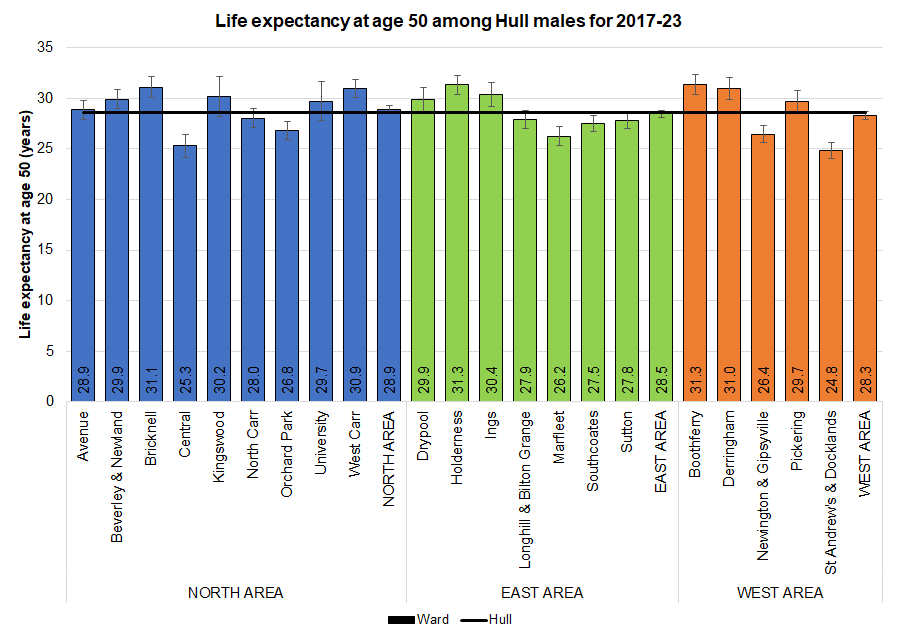
For 2017-23, female life expectancy at age 50 is higher than the Hull average for Kingswood and University wards and particularly the case for Kingswood, but statistically significantly lower than the Hull average in Central ward where female life expectancy at age 50 is the lowest of all wards at 29.0 years.
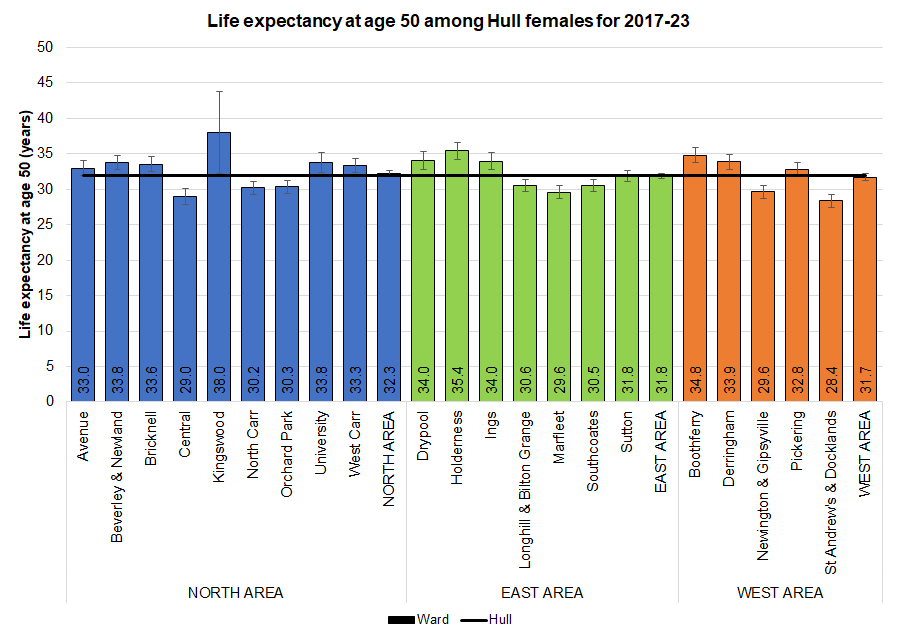
Disability Adjusted Life Years
Nationally, lower back and neck pain, coronary heart disease, stroke, chronic obstructive pulmonary disease, lung cancer, Alzheimer’s disease, sense organ diseases, depressive disorders, falls and skin diseases are the top 10 causes of disability, that is they are responsible for the highest number of disability adjusted life years (DALYs).
Strategic Need and Service Provision
Whilst increasing life expectancy is important, this needs to be achieved in conjunction with improvements in the quality of life. This is particularly so with an ageing population and the consequent increased demand on scarce health and social care resources.
Resources
L’Hôte E, Castellina M, Volmert A, Conklin L, and O’Shea P. A Matter of Life and Death: Explaining the Wider Determinants of Health in the UK. FrameWorks, 2022. Commissioned by The Health Foundation. https://www.health.org.uk/publications/a-matter-of-life-or-death
Office for Health Improvement & Disparities’ Fingertips: https://fingertips.phe.org.uk/
The Office for Health Improvement & Disparities’ Segment Tool. https://analytics.phe.gov.uk/apps/segment-tool/
Updates
This page was last updated / checked on 7 April 2025.
This page is due to be updated / checked in August 2025.